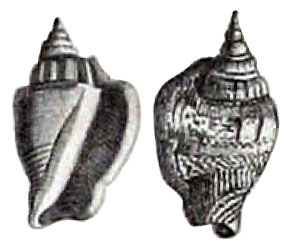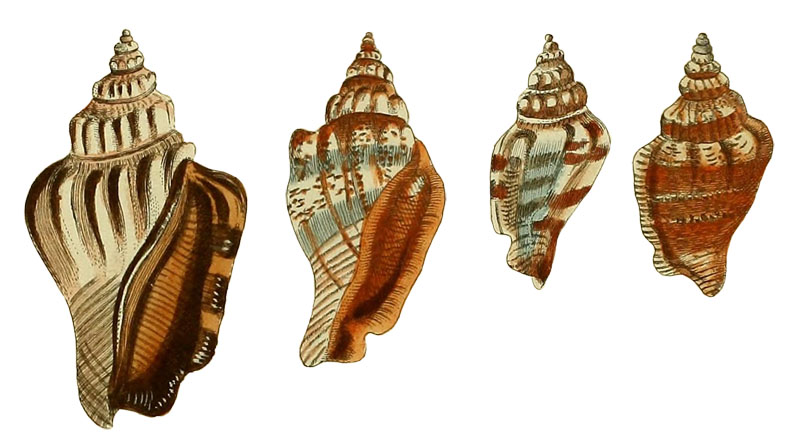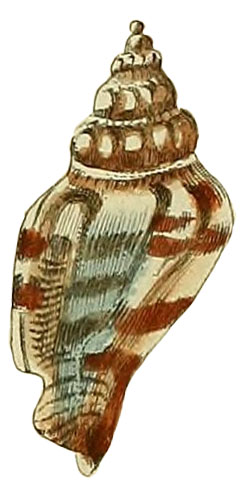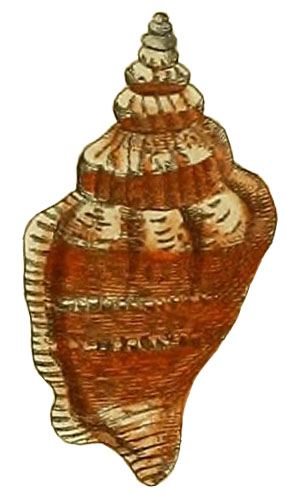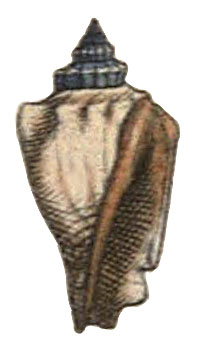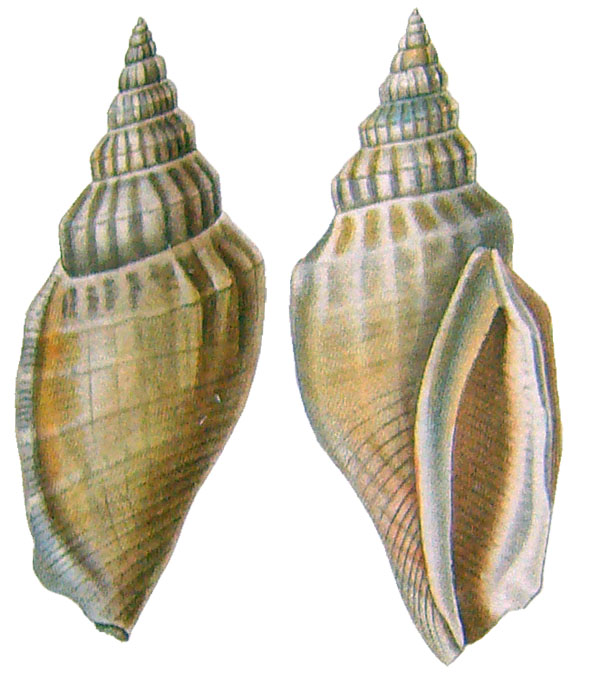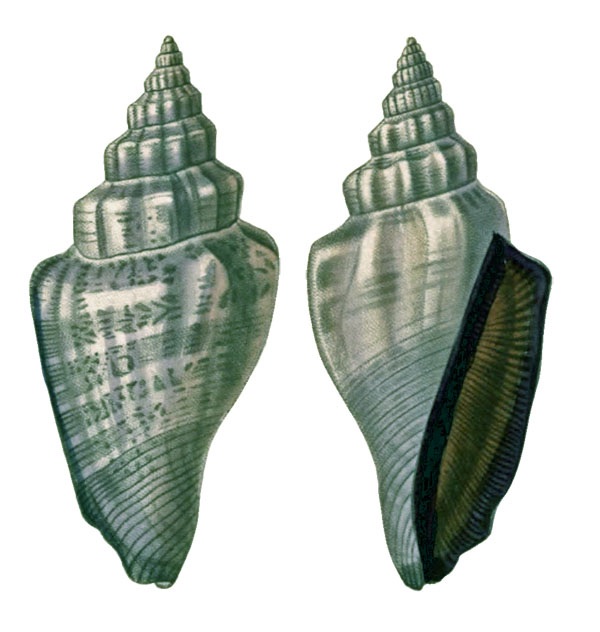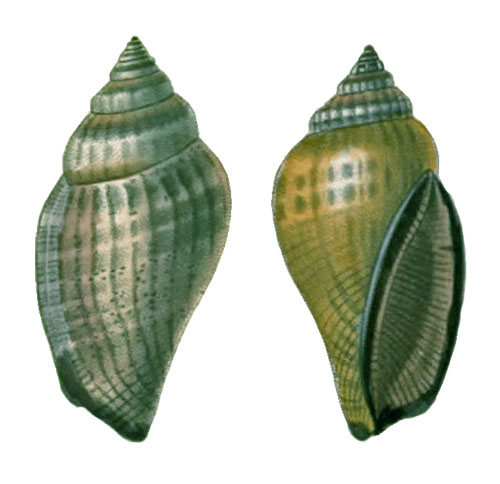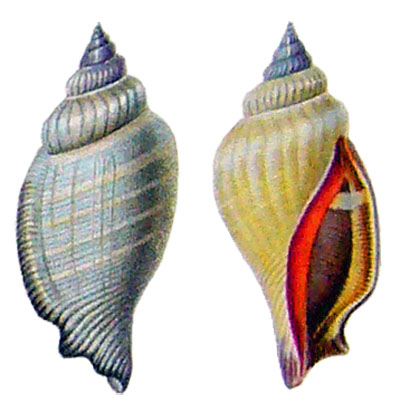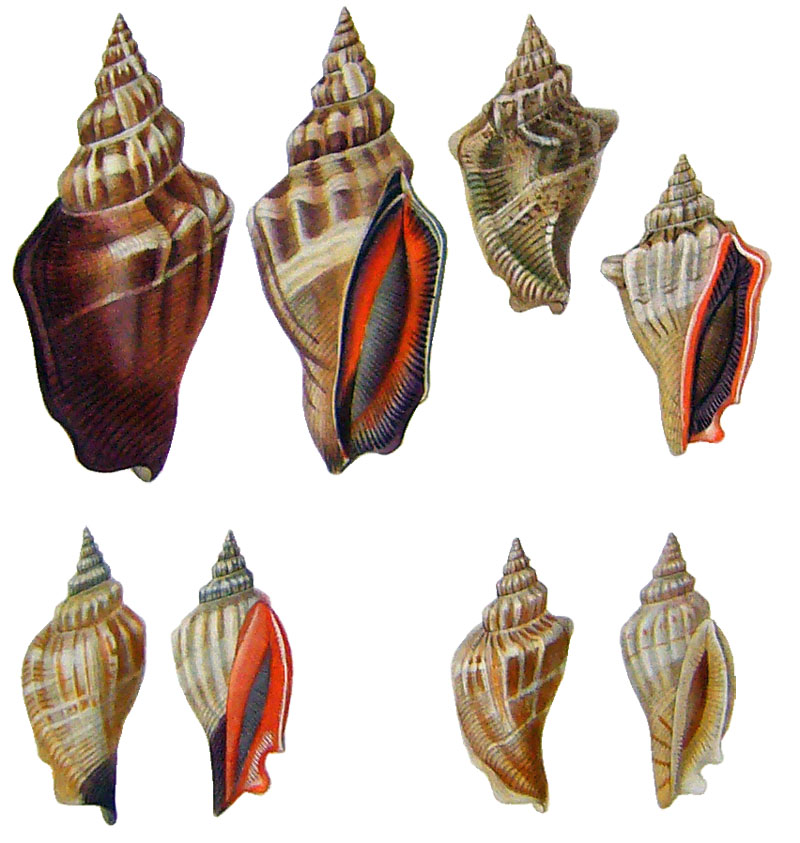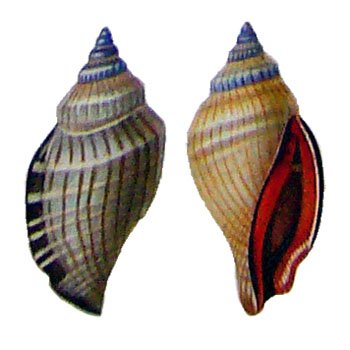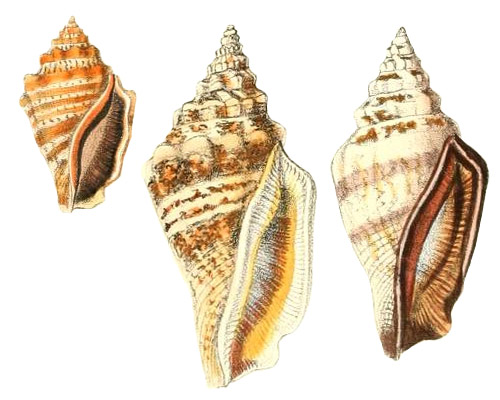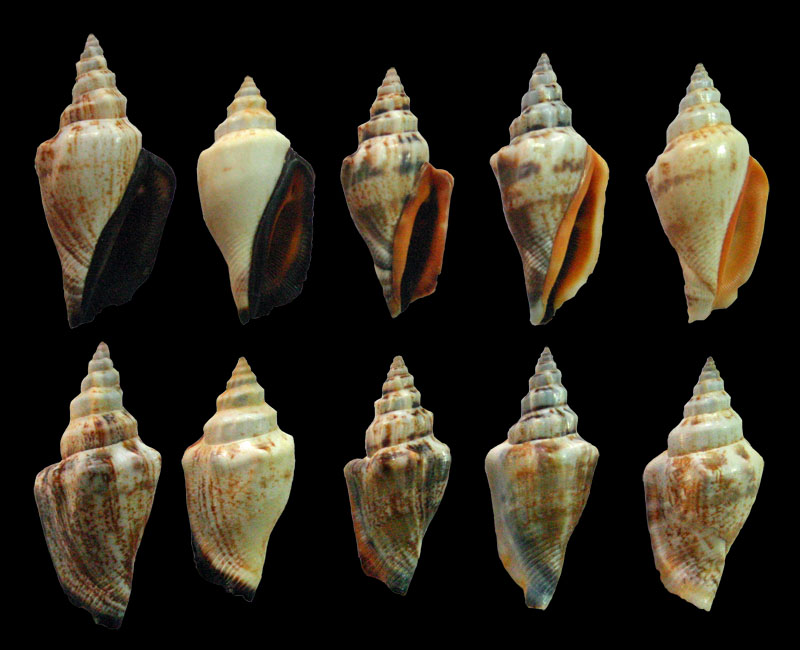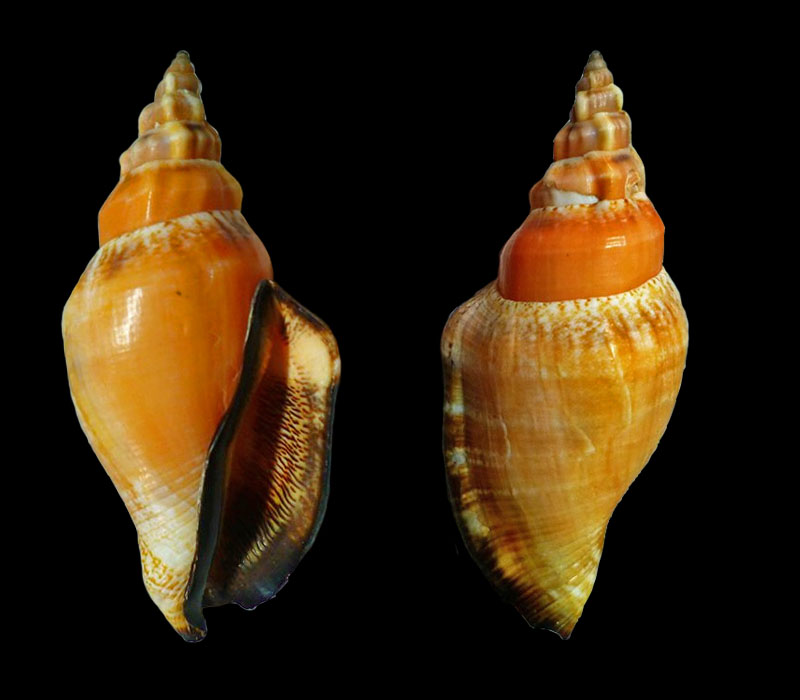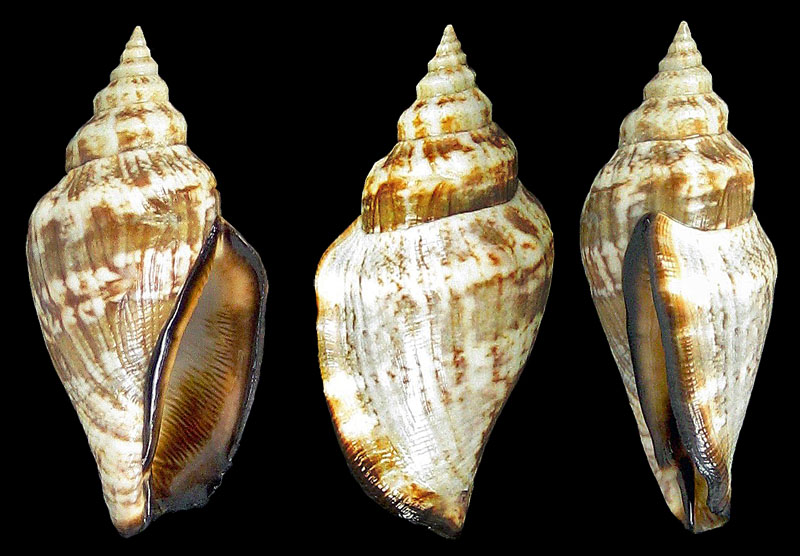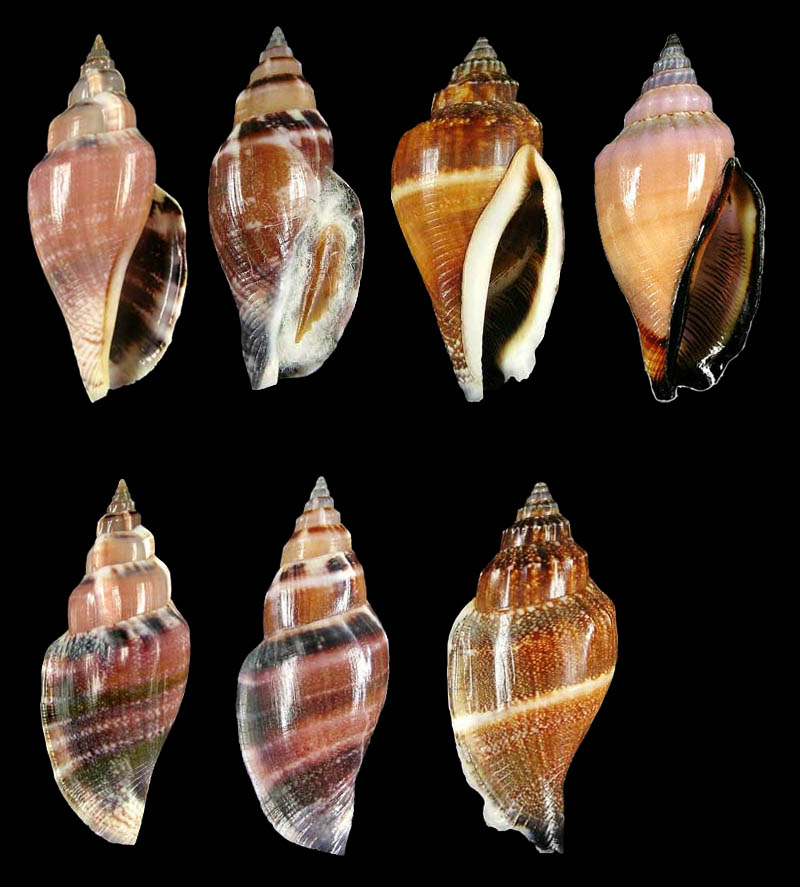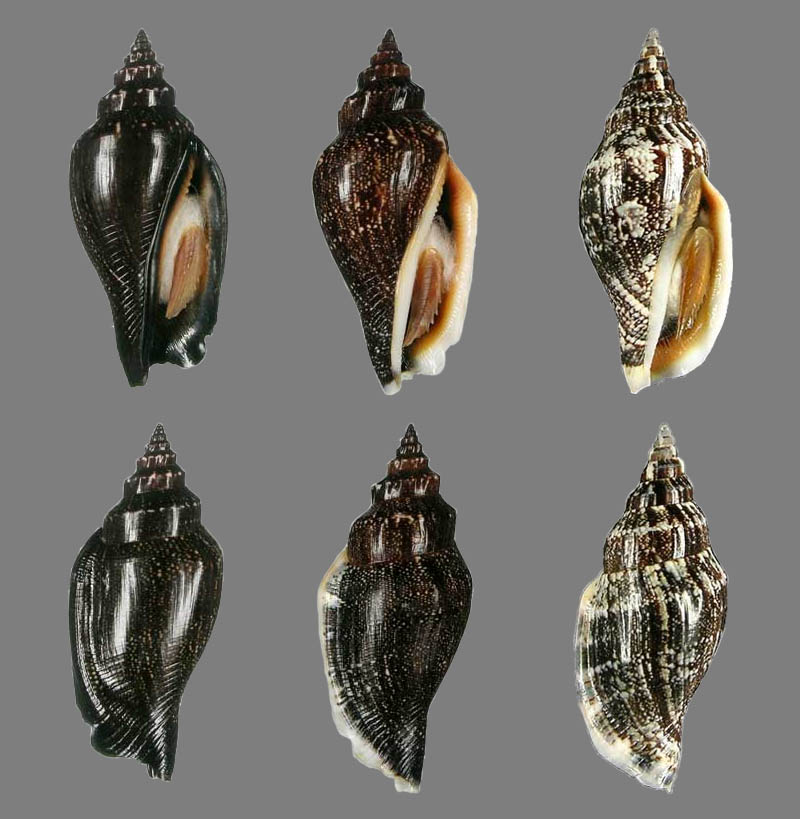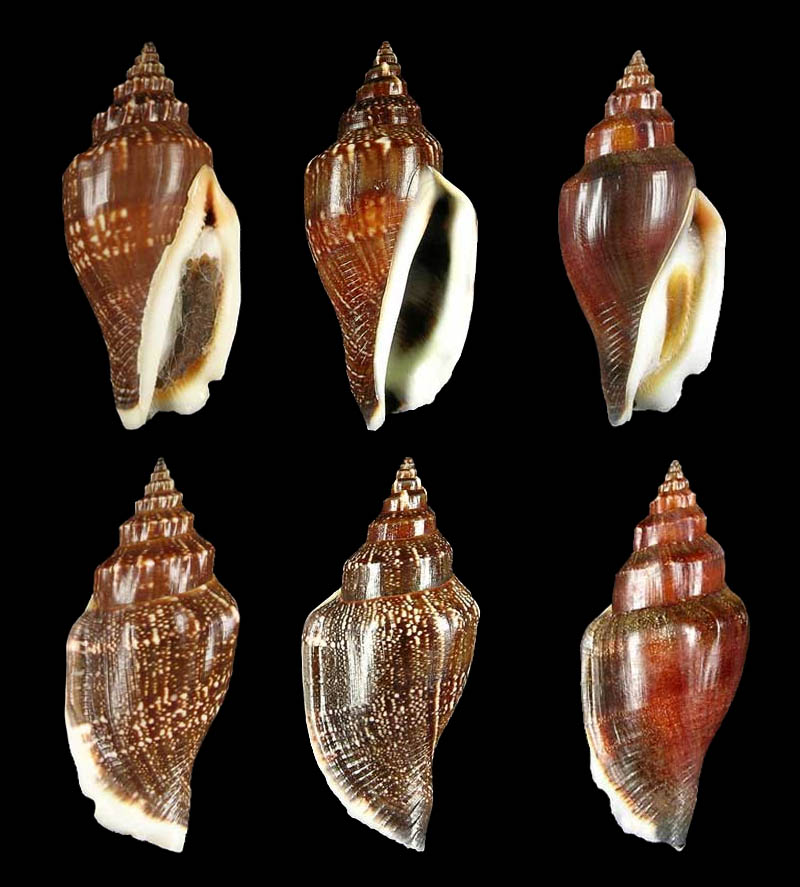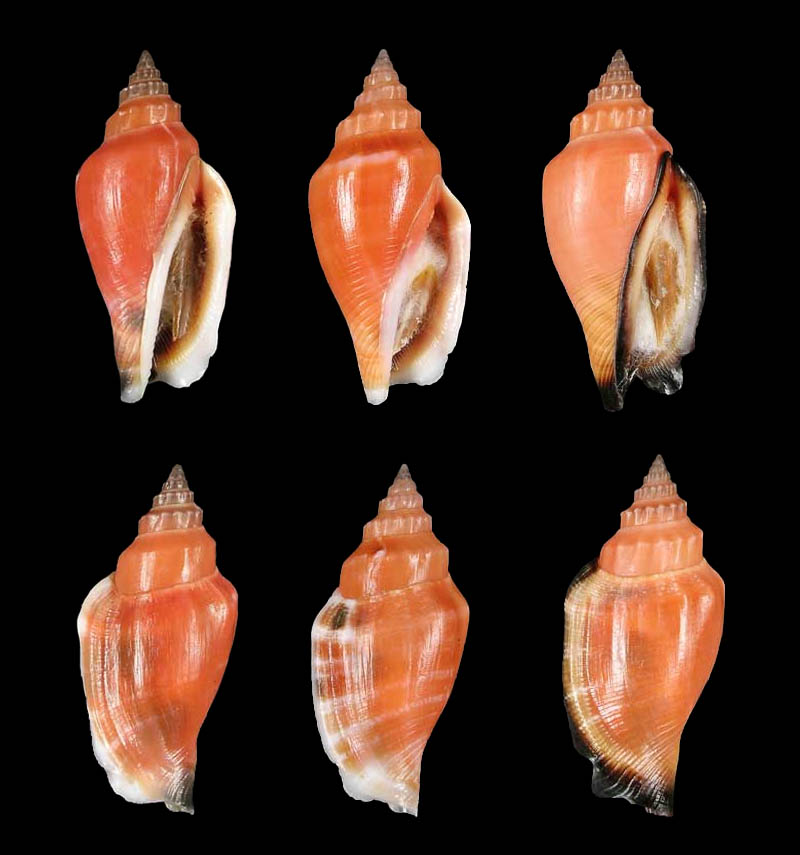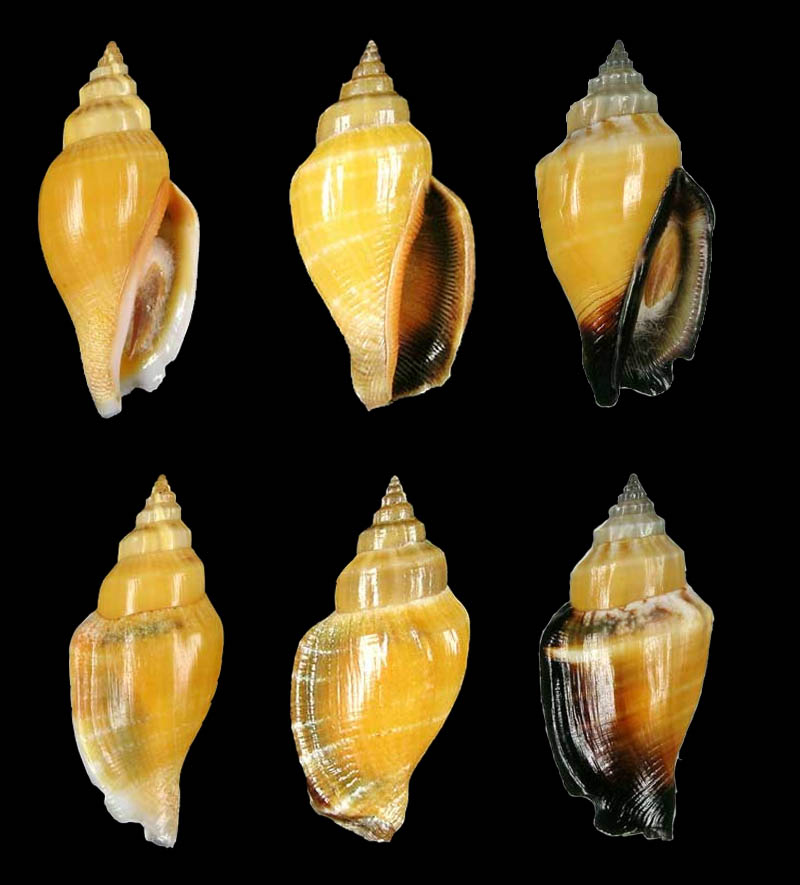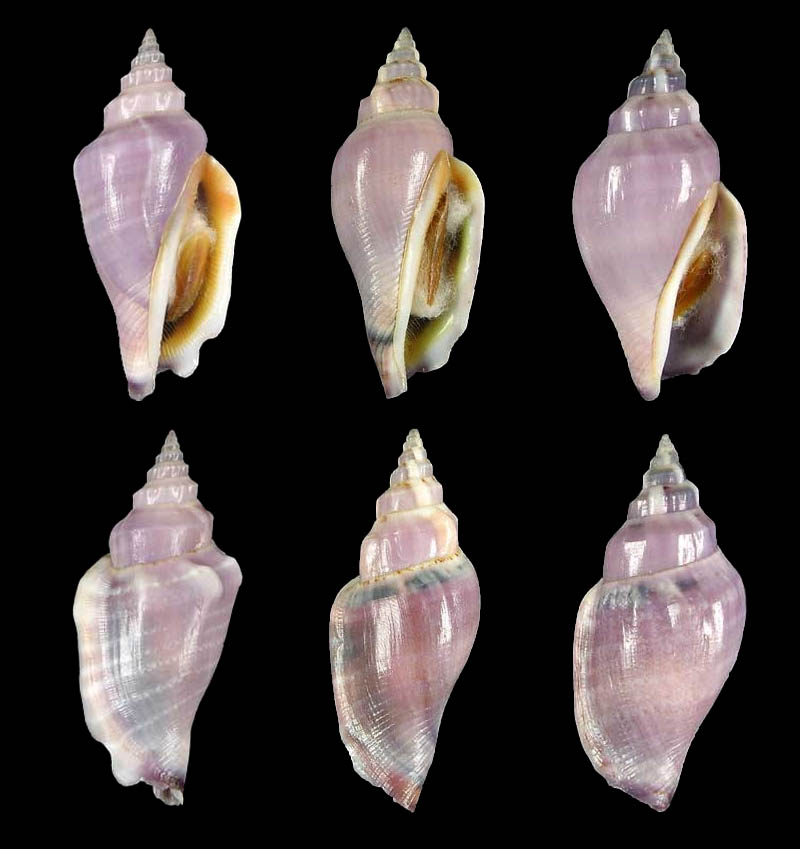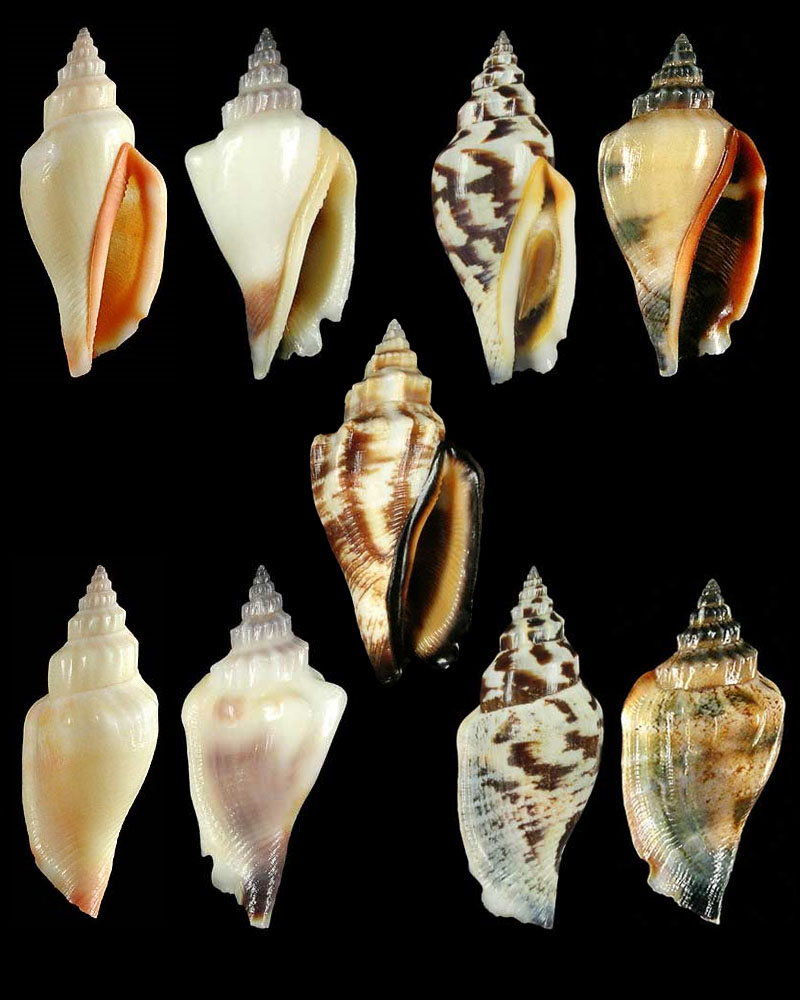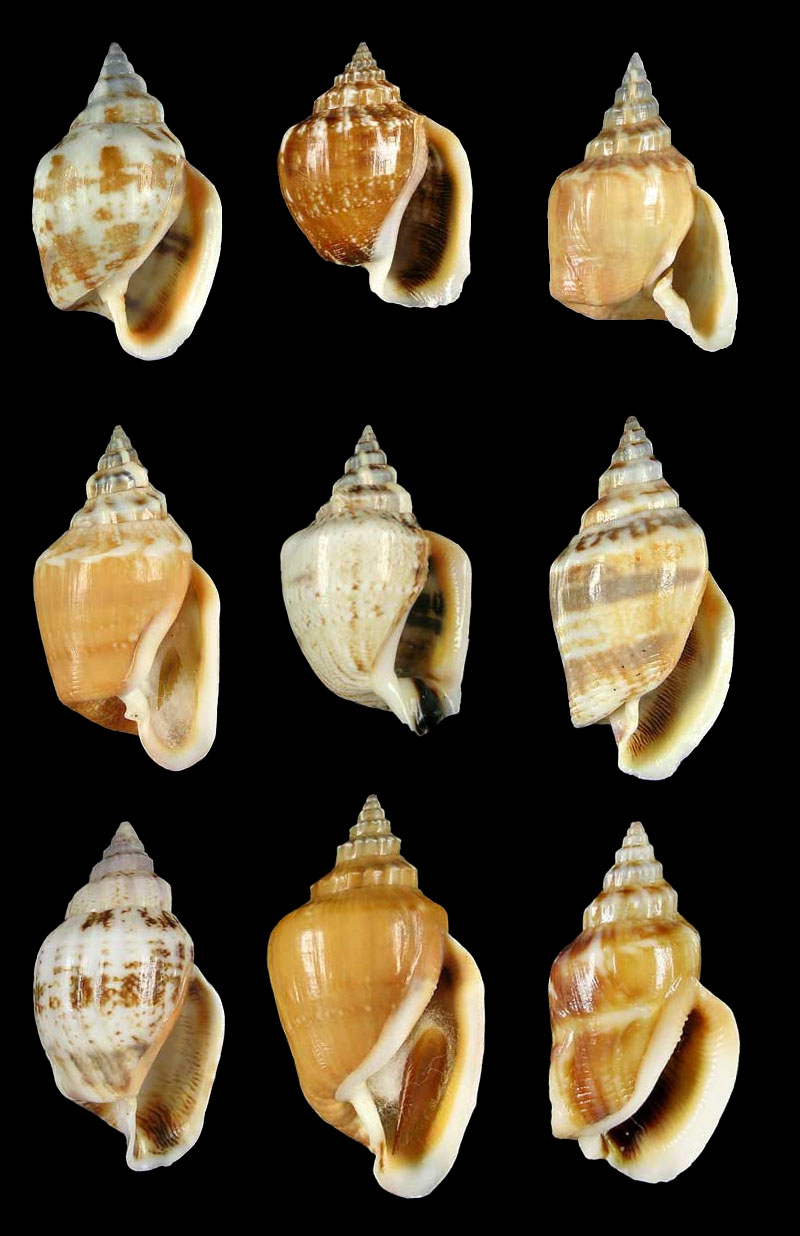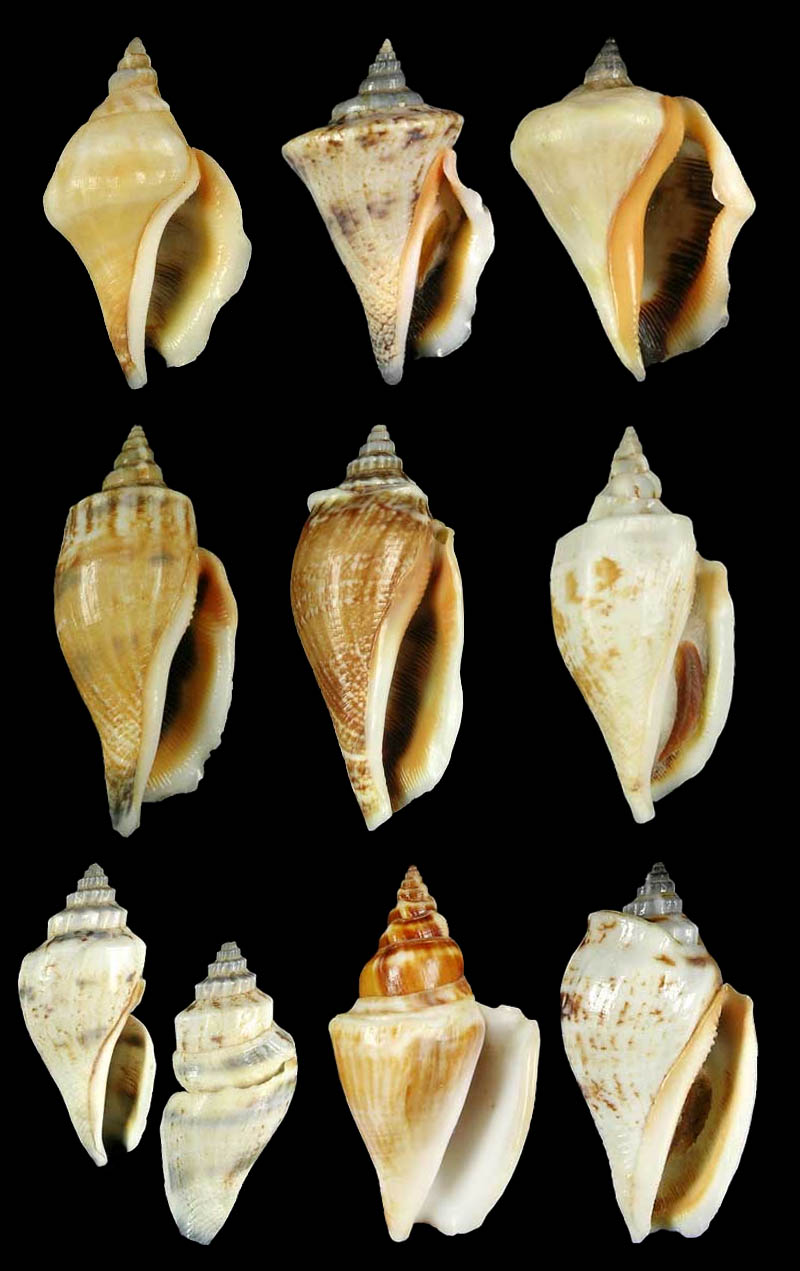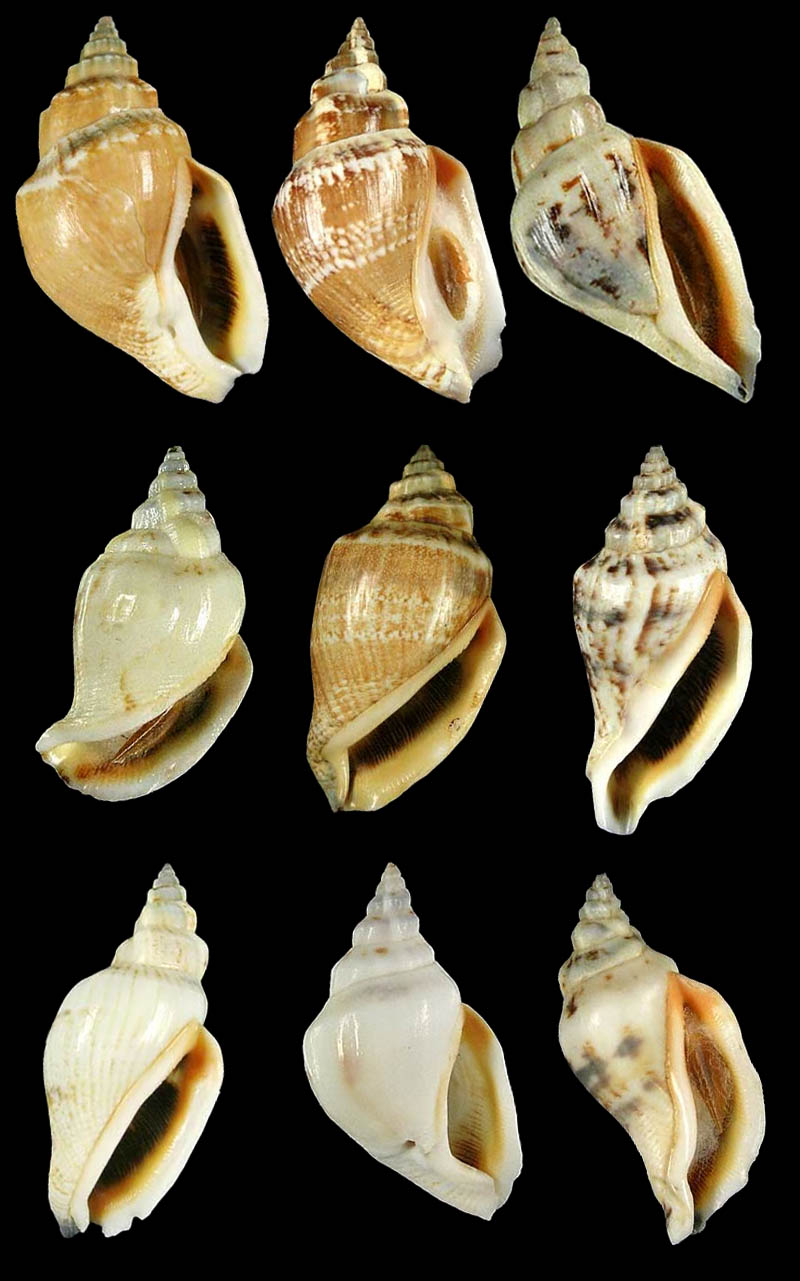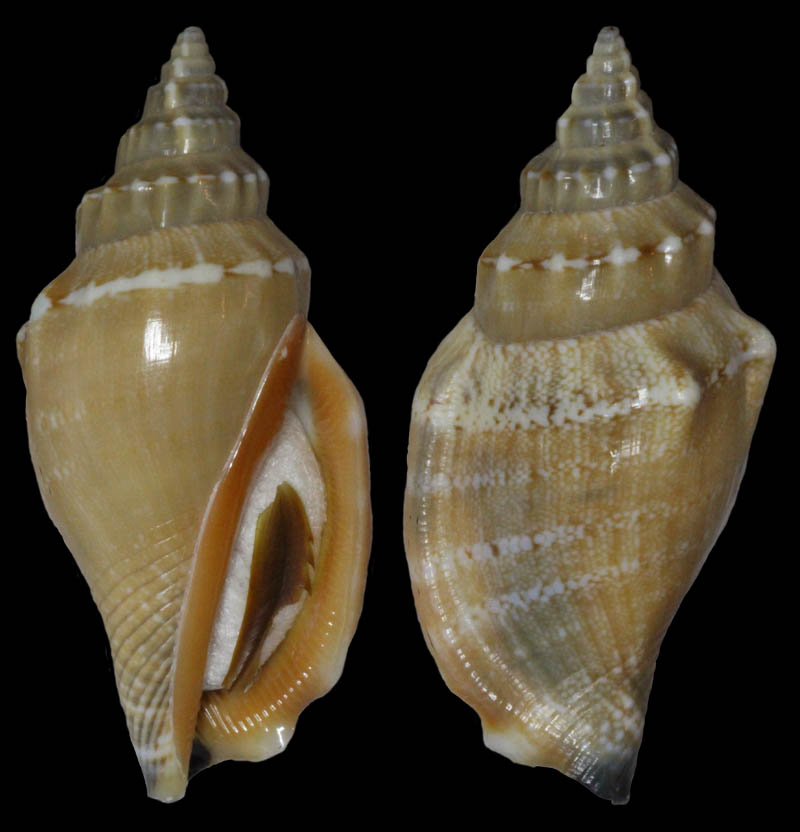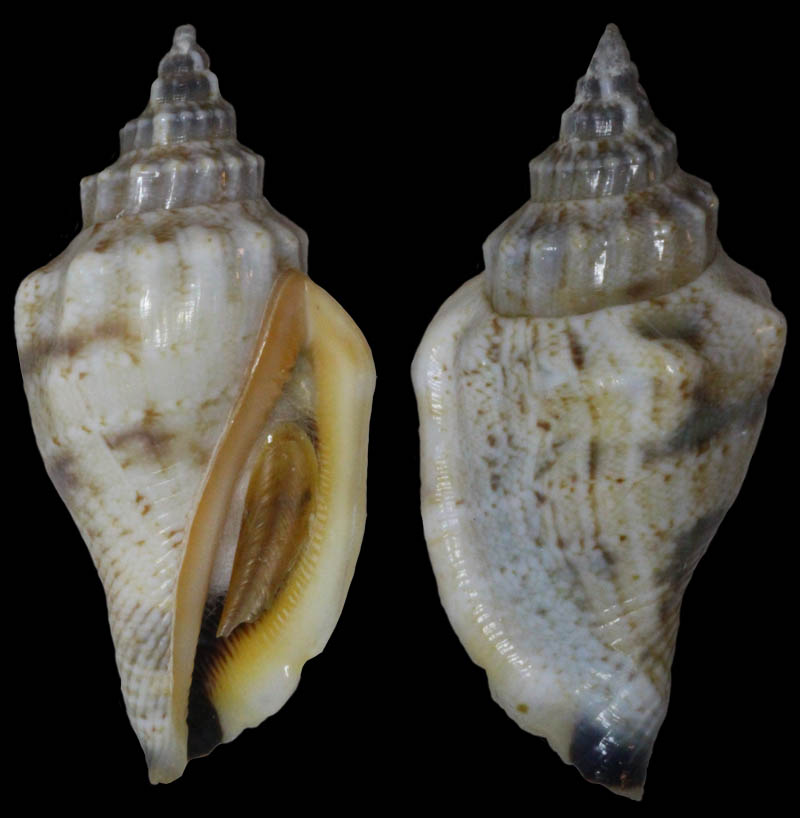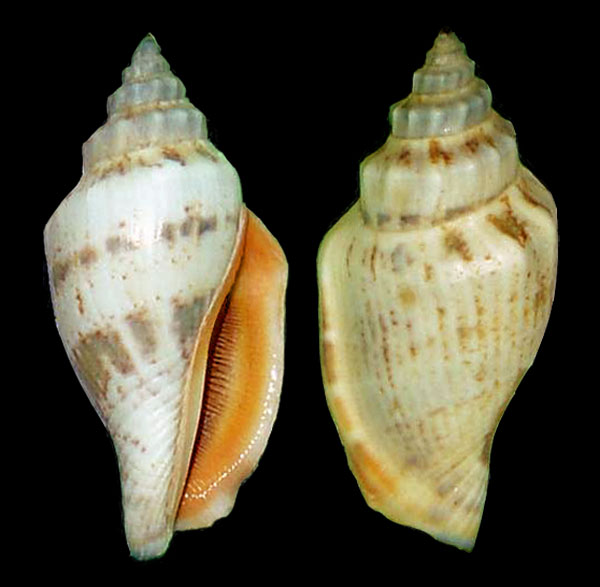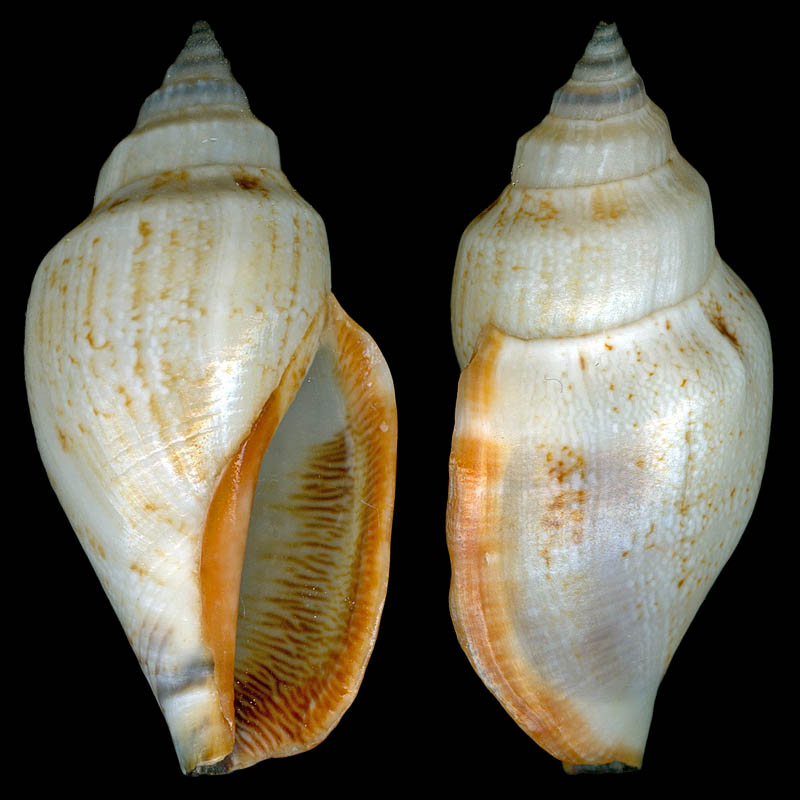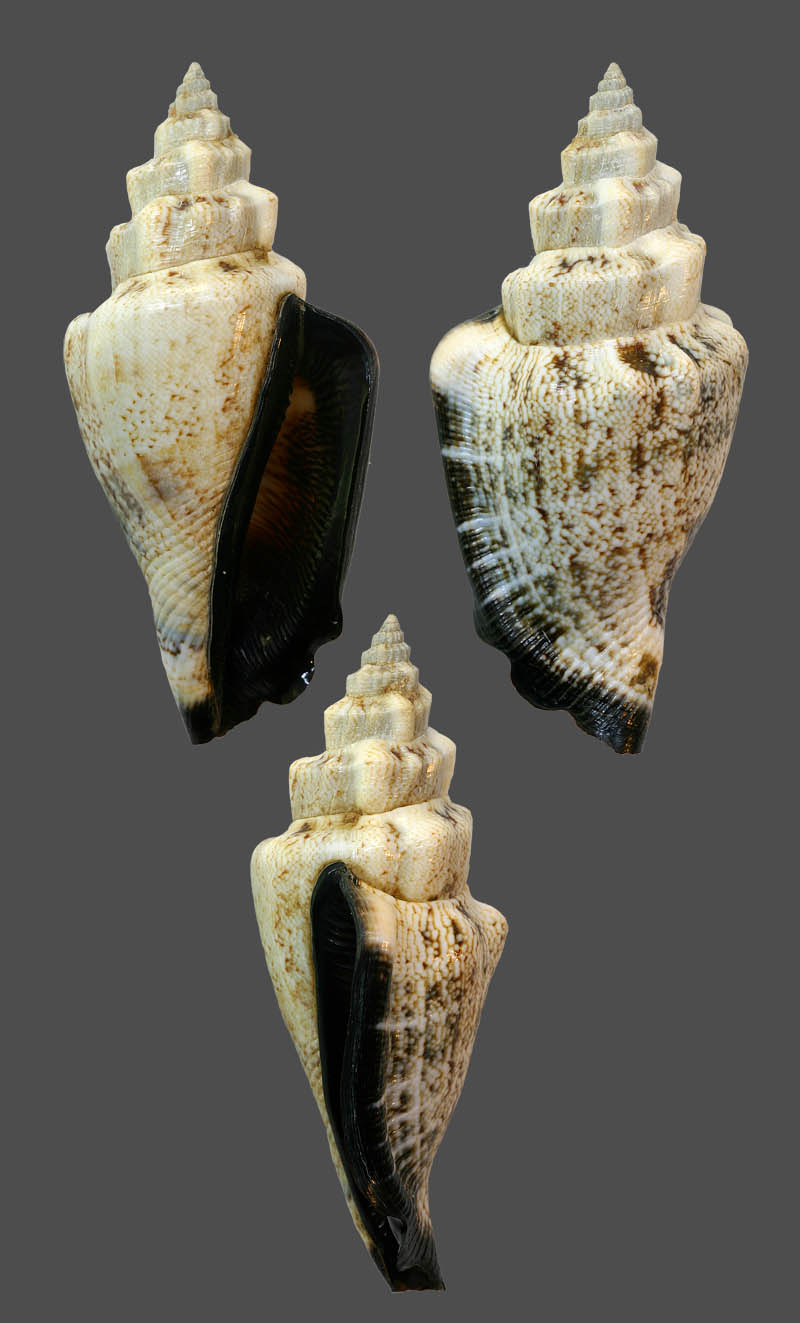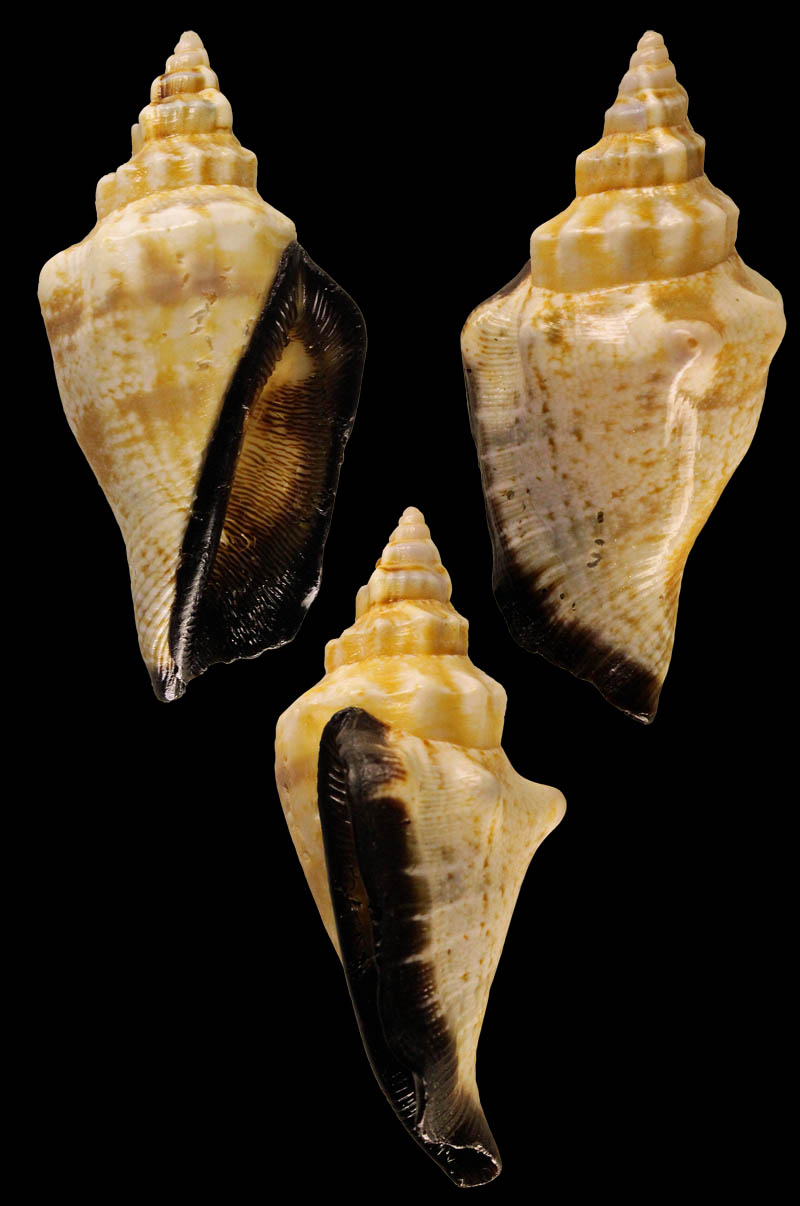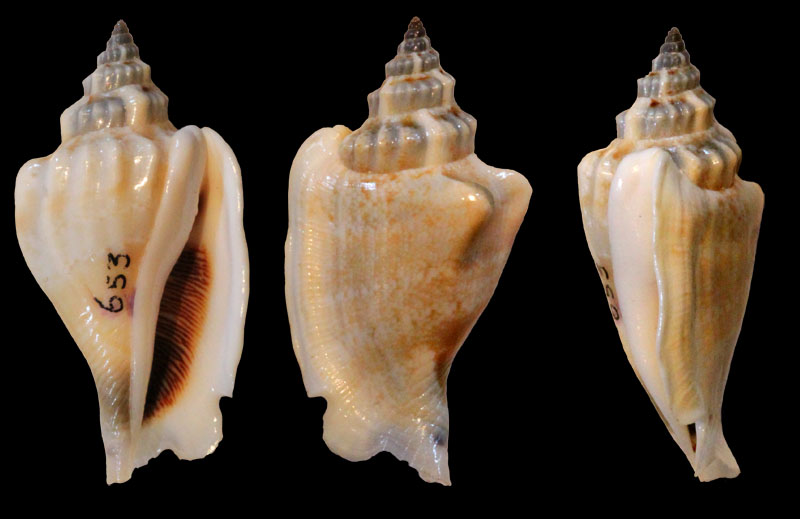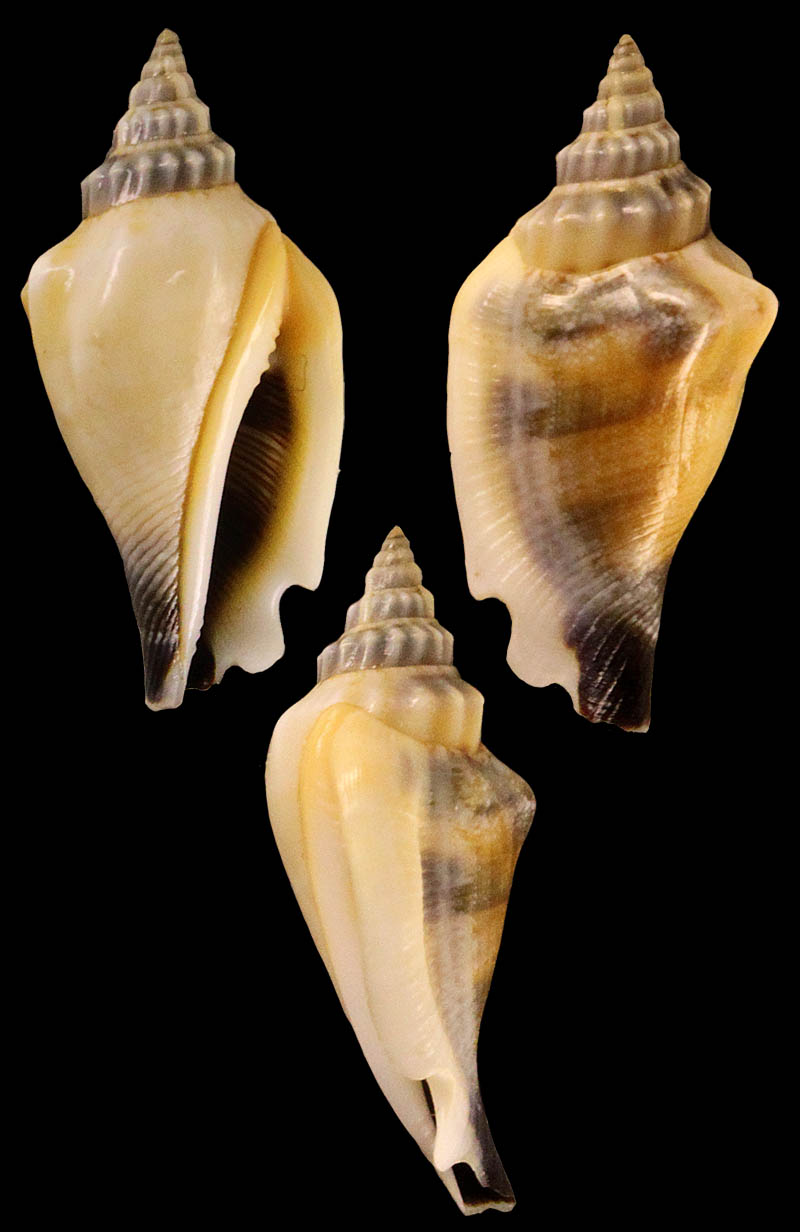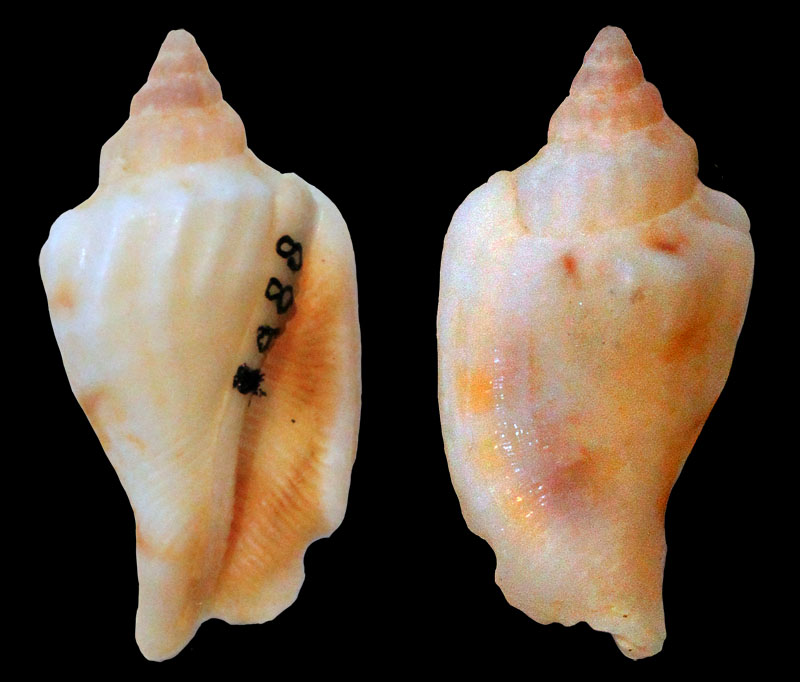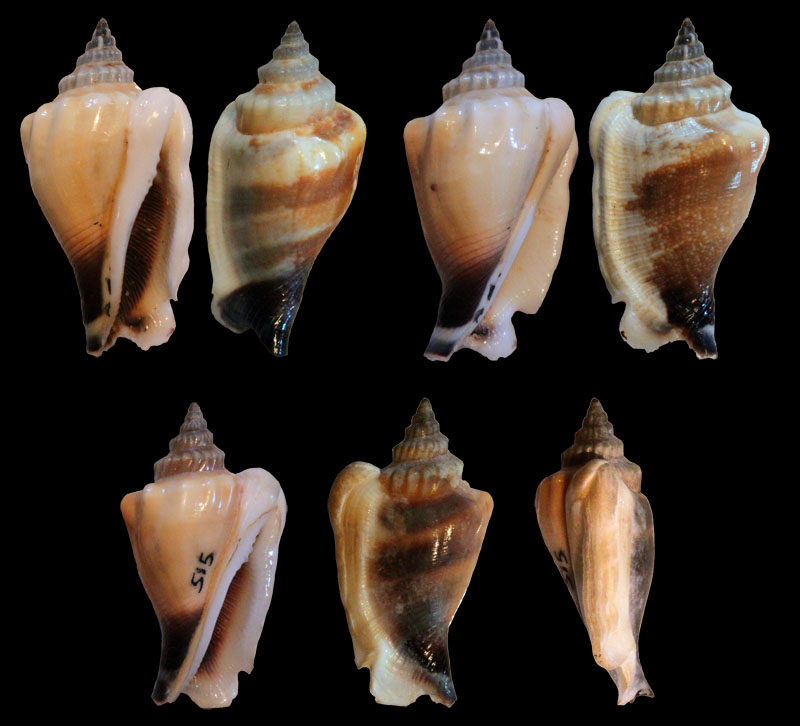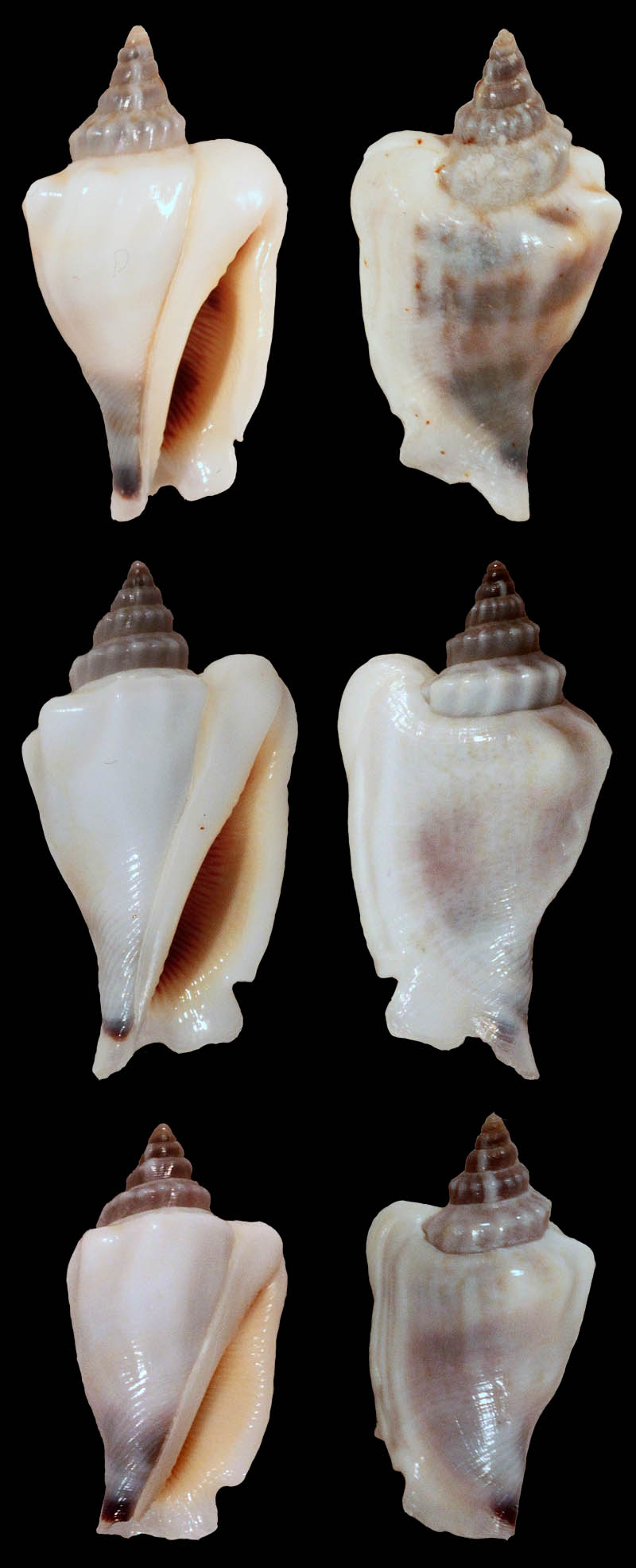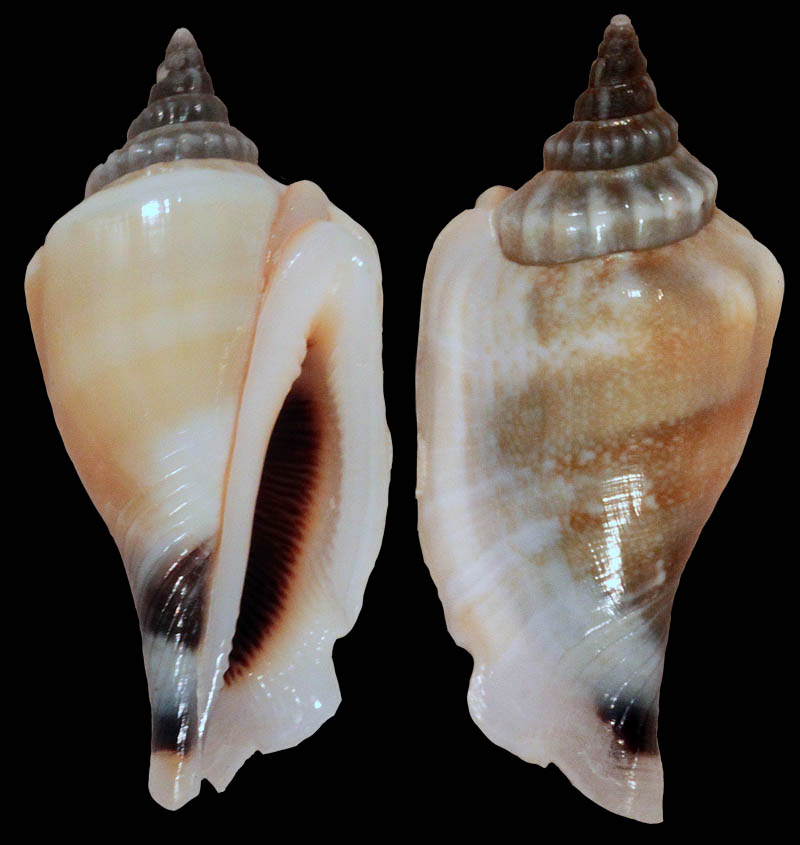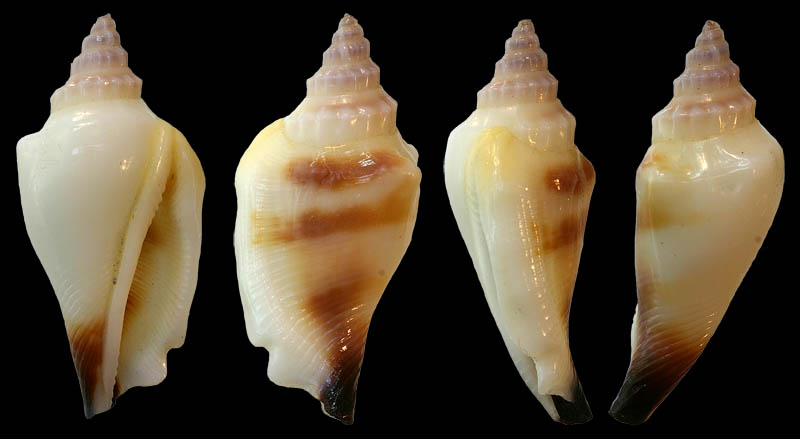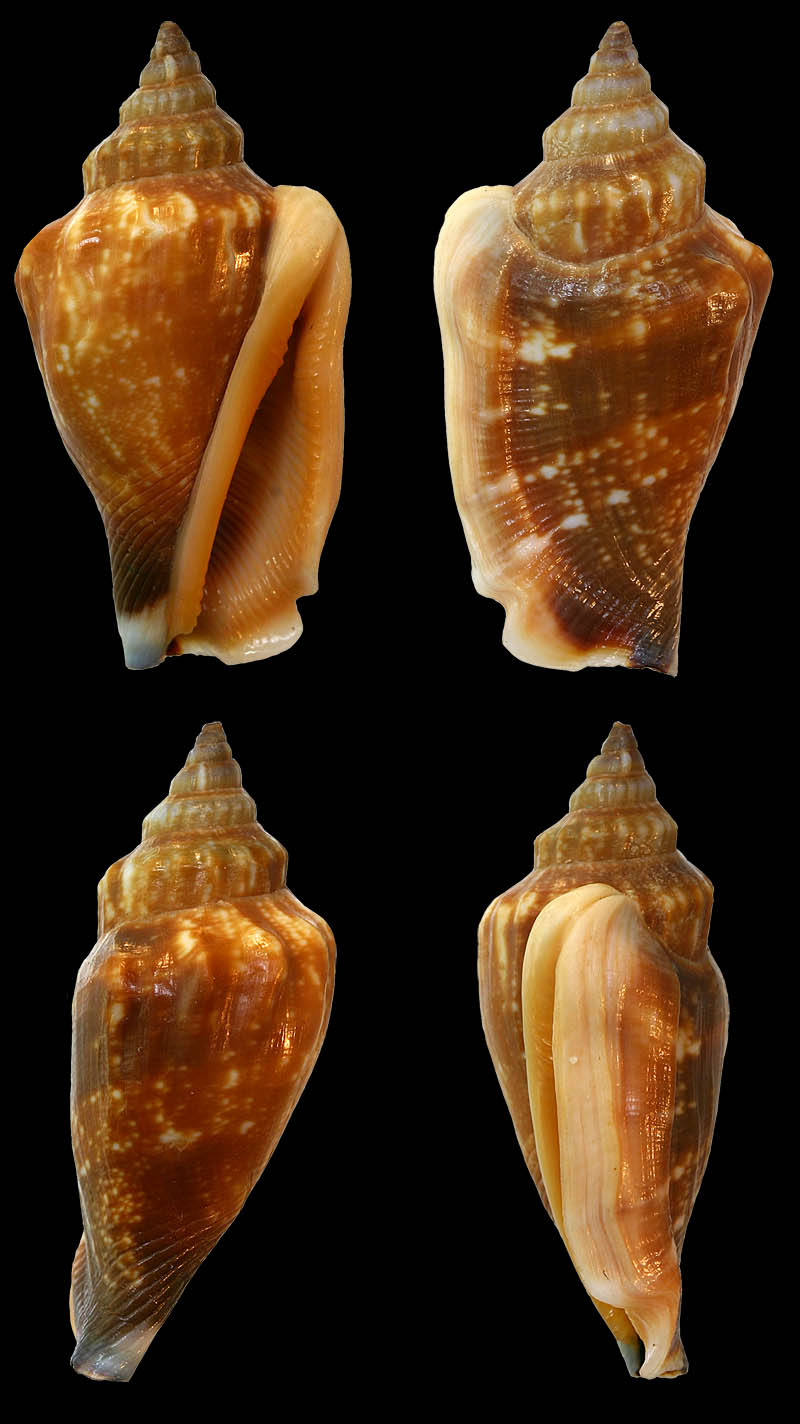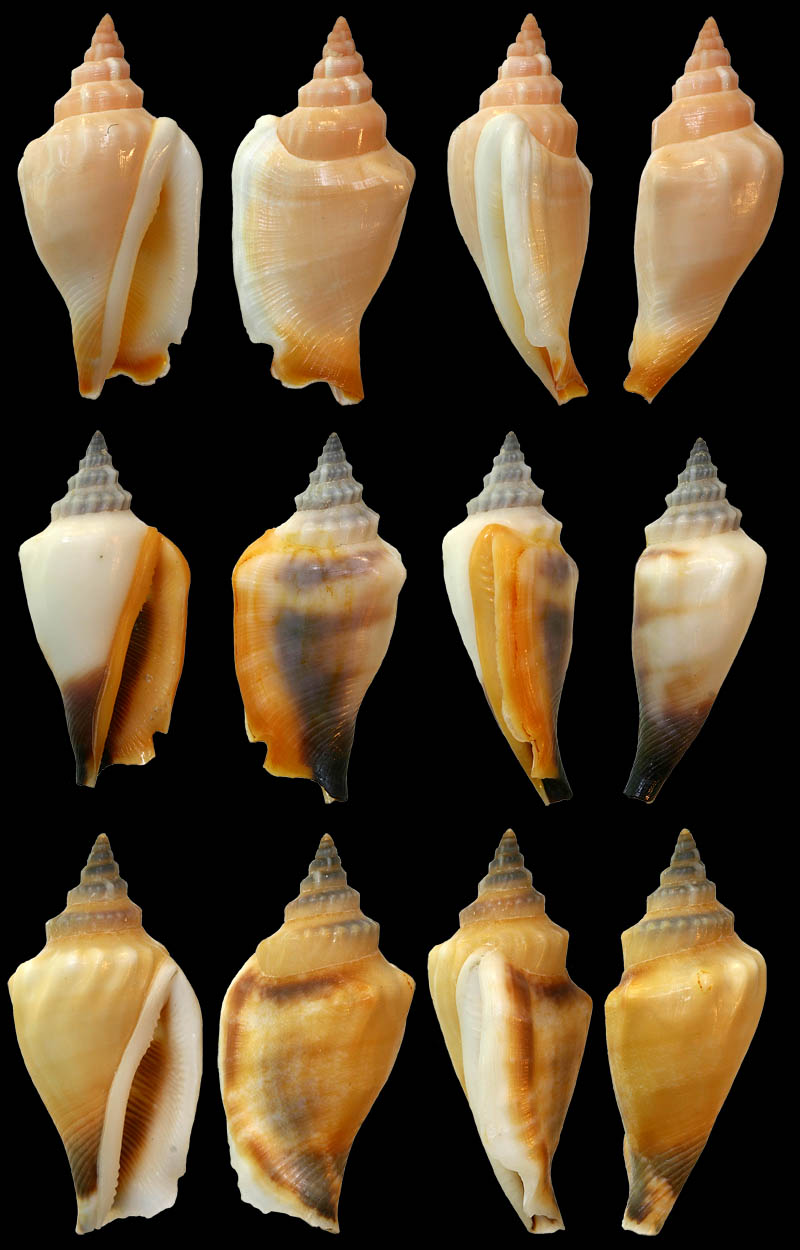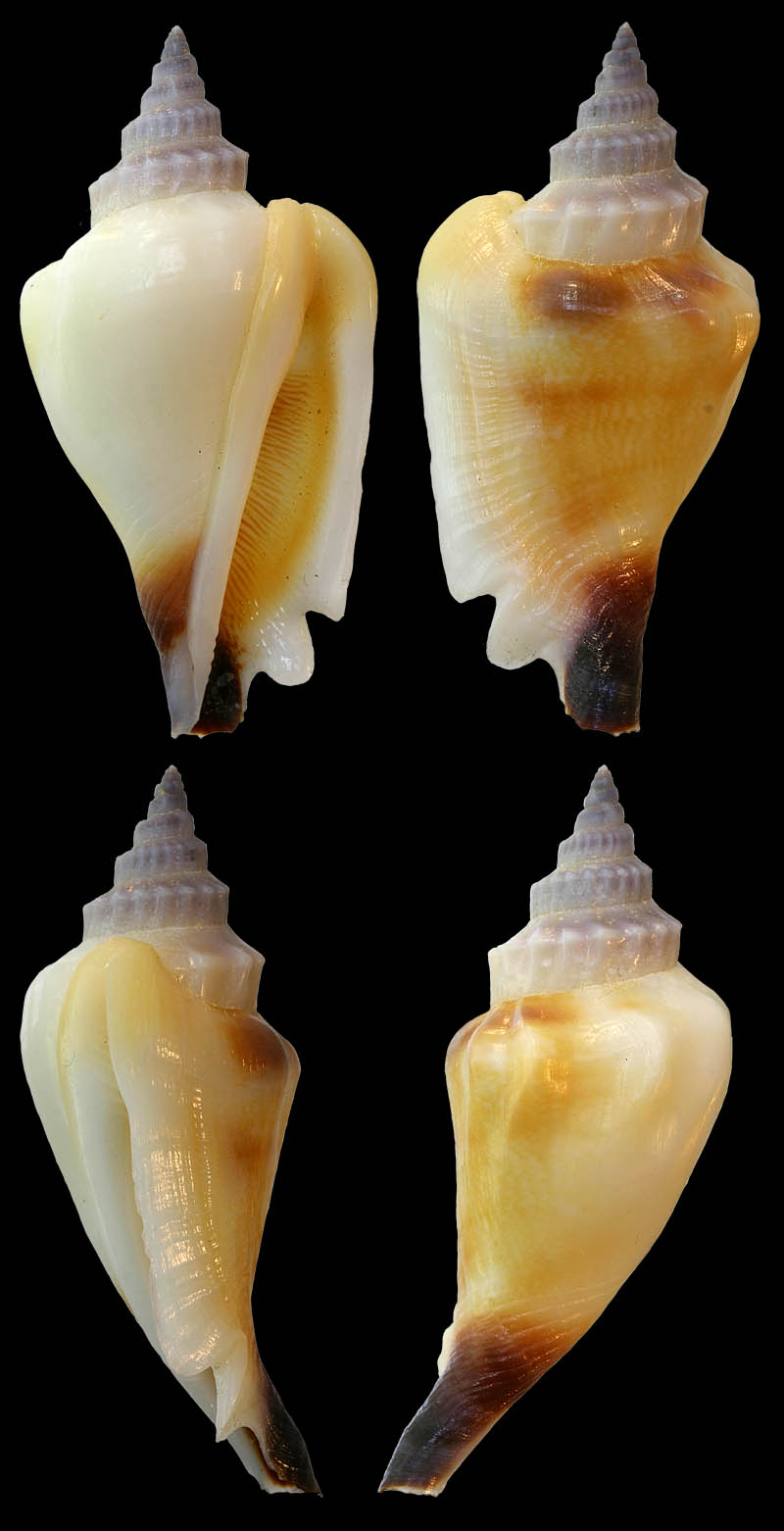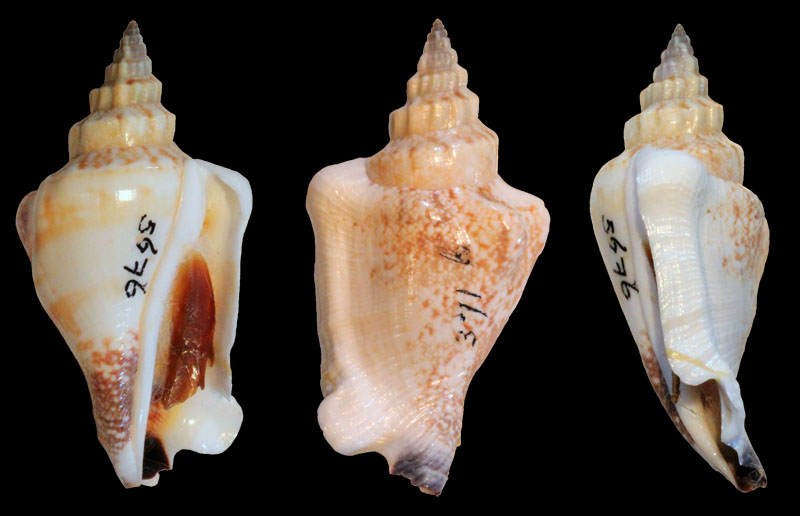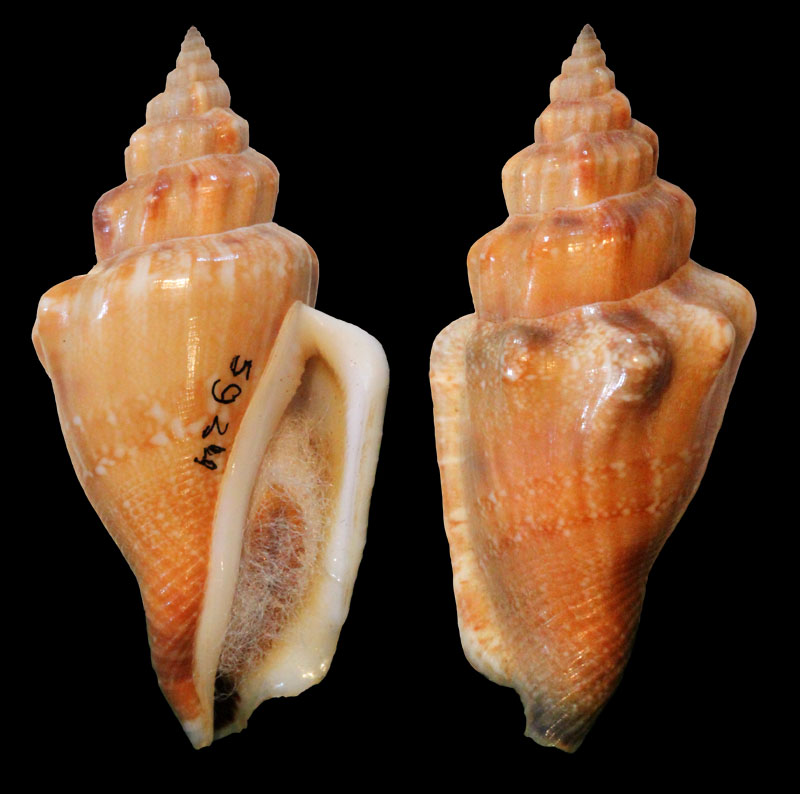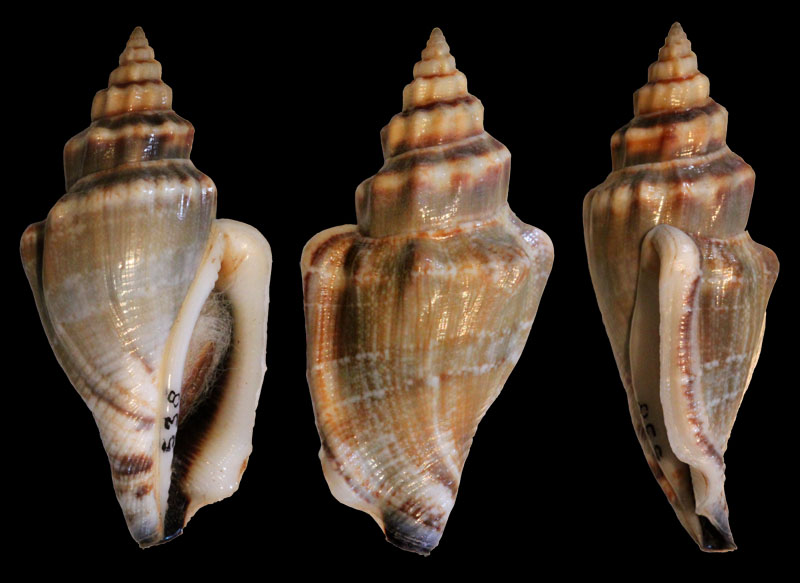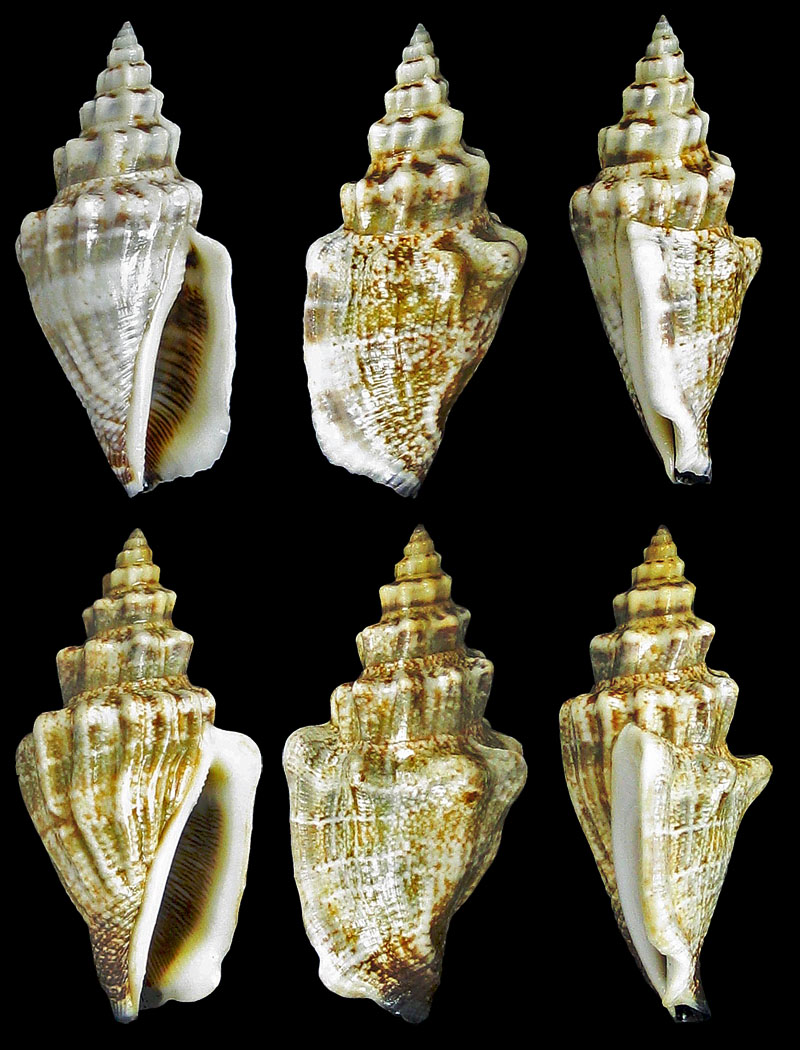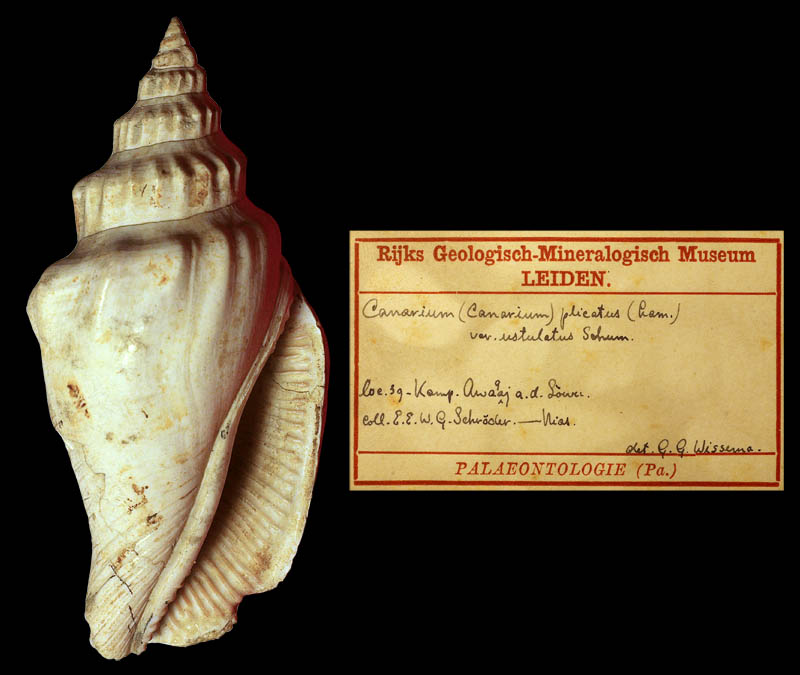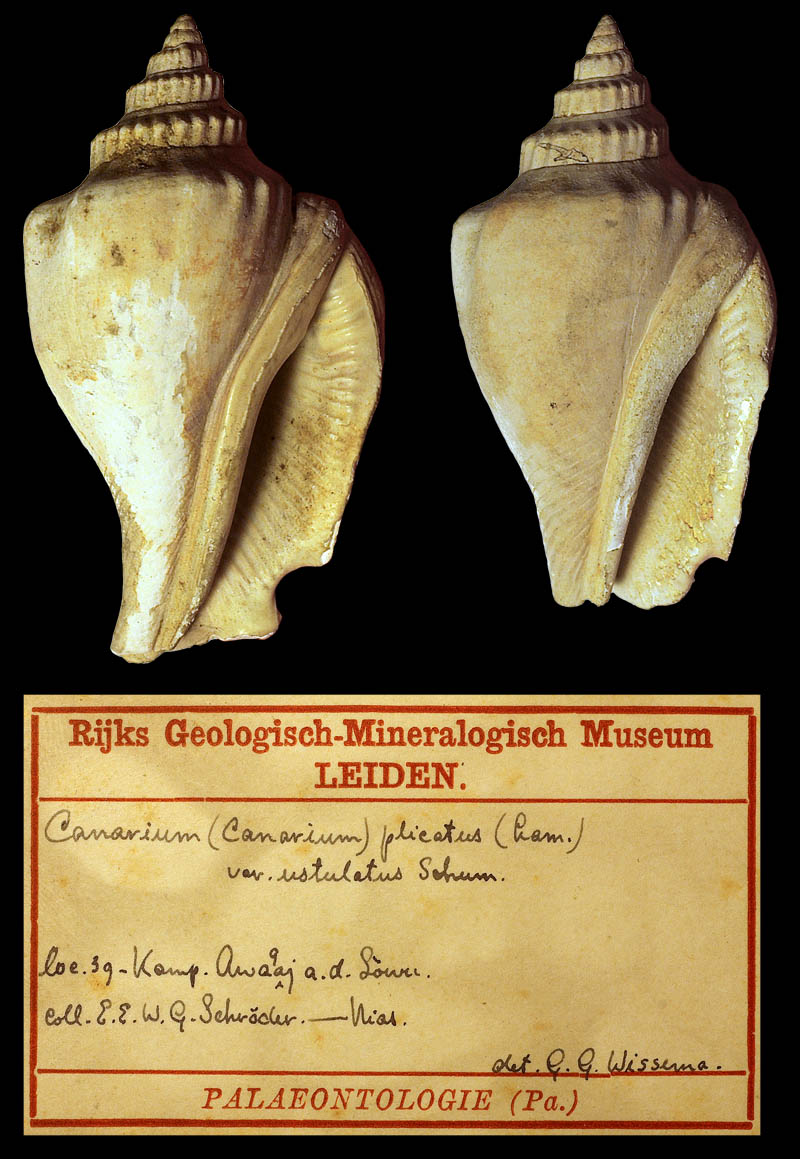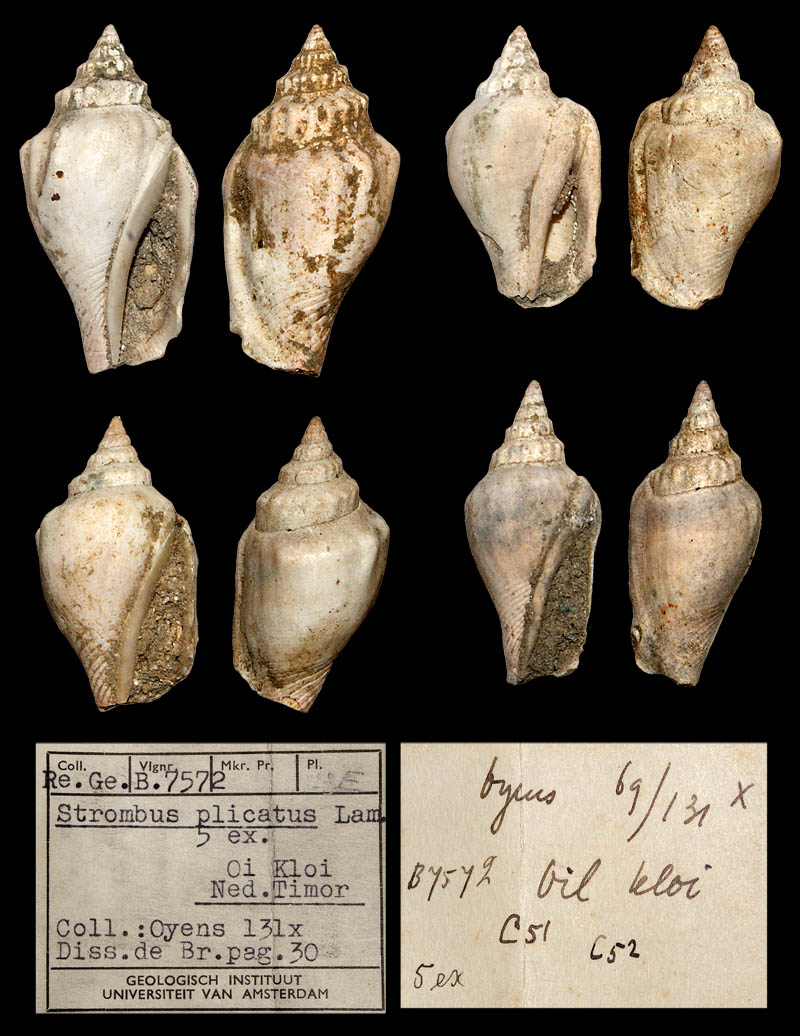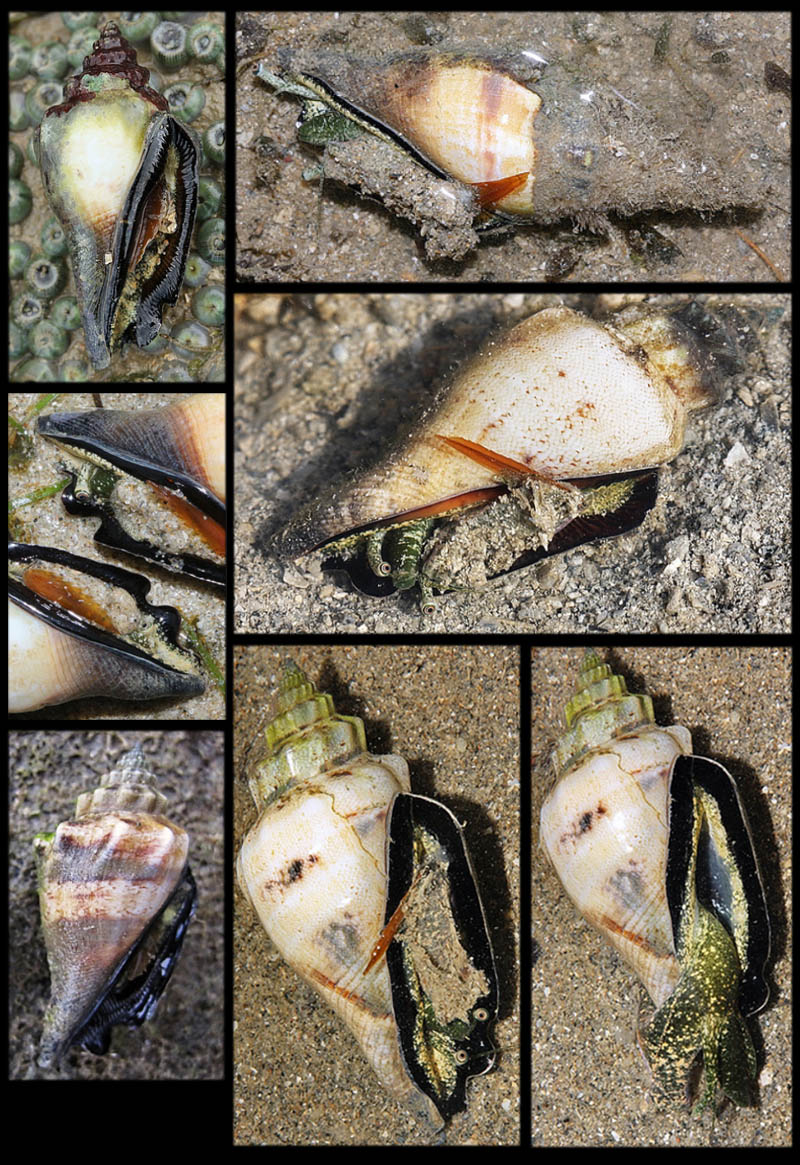|
edit SideBar
|
Species / Canarium Urceus
Stromboidea
Original Description of Strombus urceus by Linnaeus, 1758, p. 745:
- "S. testae labro attenuato retuso brevi striato, ventre spiraque plicato-nodosis, apertura bilabiata inermi."
Translation of Linnaeus' description by Dodge, 1946, p. 1:
- "Shells with a "thinned-out", reflected, short, and ridged lip, body-whorl and spire plicate-nodose, aperture bilabiate and lacking armature."
Linnaeus, 1758 cited
- "Rumph. mus. t. 37. f. T."
- "Petiv. gaz. t. 98. f. 19."
- "Gualt. test. t. 32. f. G."
Locus typicus: "Habitat in O. Asiae" (Linnaeus, 1758); Cebu Island, Central Visayas Region, Philippines (Abott, 1960)
Canarium Rumphius, 1705, pl. XXXVII, fig. T
Murex Gualtieri, 1742, pl. 32, fig. G (G. Murex, mucrone papilloso, ex albido, & fulvido punctatus, nebulatus, & variegatus. (Rumph. Tab. XXXVII. litt. T.))
- Comment: cited by Linnaeus, 1758. Gualtieri cited Rumphius, but showed a different shell (Dolomena sp), not Canarium urceus
History and Synonymy
Canarium urceus incisum (Wood, 1828: 14, pl. 4 fig. 12) [see Man in ‘t Veld, 1988]
Canarium urceus urceus (Linnaeus, 1758: 745) (Strombus)
- Syn.: Strombus anatellus Duclos in Chenu, 1844: pl. 4 figs 11, 12, pl. 21 figs 8, 9
- Syn.: Strombus urceus forma costata Romagna-Manoja, 1980a: 14 [unavailable; published as a varietal name after 1960, ICZN art. 15.2]
- Syn.: Strombus ustulatus forma laevis Dodge, 1946: 2, 7, figs 1, 6 [unavailable; homonym of Strombus laevis Perry, 1811 = Euprotomus bulla]
- Syn.: Strombus muricatus Martini. Watson, 1885: 417
- Syn.: Strombus (Canarium) urceus orrae Abbott, 1960: 66, pl. 20 fig. 28, pl. 41 fig. 5
- ? Syn.: Lambis reticulata Link, 1807: 108
- Syn.: Canarium ustulatum Schumacher, 1817:219
1777
Kanarienschnecke Martini, 1777, pl. 78, fig. 803-806
- Comment: figs. 804, 805 are cited by Roeding, 1798 as Lambis labiata, see Canarium labiatum
- fig. 806 is cited by Link, 1807 as ''Lambis reticulata""
1807
Link, p. 108:
- "L. Urceus. Schwarzlippige Fl. Linn. Gm. p. 3518. Mart, Conch. 3. t. 78. f. 805. - L. reticulata. Feinmarmorirte Fl. Mart. Conch. 3. t. 77. f. 806. Verblichen.
Kanarienschnecke in Martini, 1777, pl. 78, fig. 805
Kanarienschnecke in Martini, 1777, pl. 78, fig. 806
- Cited by Link as L. reticulata, Martini placed it in Strombus urceus Linnaeus (p. 98ff.)
1817
Description of Canarium ustulatum (Canaris brulé) by Schumacher, 1817, p. 219:
- "Martin. 3. pag. 98 Tab. 78. fig. 803 805. Mr. Martini croit avoir fait dessiner dans ces figures le Strombus urceus Lin.; mais, à mon avis, on retrouve plutôt cette coquille de Lin. dans la figure 806 de la même planche, comme elle s'accorde très bien avec la figure de Rumph. Mus. Tab. 37. fig. T, qui a été citée par Linnaeus comme sa coquille, et marquée par lui par le mot bene; marque qu'on doit toujours observer dans son système."
1828
Original Description of Strombus incisus by Wood, 1828, p. 14:
- "incisus notch-lipped Br. M. [British Museum] u.[Habitat unknown]"
Strombus incisus Wood, 1828, pl. 4, fig. 12
1843
Strombus urceus var. in Kiener, 1843, pl. ?, fig. 2
Strombus urceus in Kiener, 1843, Vol. 4, Strombus pl. 30, fig. 2; "Image courtesy Biodiversity Heritage Library. http://www.biodiversitylibrary.org"
Strombus urceus var. in Kiener, 1843, Vol. 4, Strombus pl. 30, fig. 3; "Image courtesy Biodiversity Heritage Library. http://www.biodiversitylibrary.org"
1844
Strombus anatellus Duclos in Chenu, 1844, pl. 4, fig. 11, 12
Strombus dentatus var. urceus in Duclos, 1844, pl. 5, fig. 8, 9, 10, 11, 12, 13, 14, 15
Strombus anatellus Duclos in Chenu, 1844, pl. 21, fig. 8, 9
1850
Strombus urceus Reeve, 1850, Strombus, pl. 11, fig. 24 a, b, c
1855
Comment on Strombus urceus by Hanley, 1855, p.275:
- "One regrets to disturb a long-established identification, yet truth compels me to declare that the S. urceus of modern writers is not the true representative of the species thus named by our author [Linnaeus]. We shall not find among the synonyms a single characteristic drawing of that shell, an absence not to be accounted for by none such being then extant, since, besides having been delineated by Bonanni (pt. 3, f. 144), a writer peculiarly consulted by Linnaeus, it has been engraved, likewise, in those very works wherein different figures were referred to as illustrative. On the contrary it is the S. mutabilis (Seba, Mus. vol. iii. pl. 60, f. 28, &c.), and the S. plicatus (Rump. pl. 37, f. T, &c.), the former of which is marked for this species in the Linnean cabinet, where the suppositious urceus is not present, to which our attention is directed by the references. Indeed, the remarkable colouring of the aperture of that shell would scarcely have been passed over in the description: assuredly the "dorso nodis 3 seu 4" can be more correctly affirmed of mutabilis than of either of the others. The expression "labro attenuato" having been considered equivalent to "labri margine attenuato," though possibly meant only to contrast the lip itself with the expanded and lobated form of that part in its congeners, has probably misled naturalists; the edge of the outer lip in the type, however (Sow. Thes. Conch. vol. i. pl. 7, f. 45, but not so distinctly banded) is actually attenuated."
1885
Strombus (Canarium) muricatus Watson, 1885
Comment by Watson, 1885, p. 417:
- "This species, as Mr Hanley has pointed out (Wood, Ind. Test., Strombus urceus, p. 124, sp. 32, Strombus floridus, Lam., p. 215, sp. 5, and also Ipsa Linn. Conch., p. 275), is Strombus urceus, auctorum nec Linnei. The mistake began early, and has continued persistently. The disturbance of a long-established identification is much to be regretted, as Mr Hanley has truly said; but the transference of Linne's name from this species to the species to which he really applied it is inevitable when a witness so capable as Mr Hanley assures us that this species we have before us now is not to be found in Linne's collection, and that the shell preserved in Linne's cabinet, and marked by him as Strombus urceus, is not the Strombus urceus auctorum, but the Strombus mutabilis, Swainson, the Strombus floridus, Lam. In selecting a name for this now nameless species, I have taken that of Martini as the earliest I could find. Of course, the later application by Schröter of this same name to the Cerithium uncinatum, Gm., is absolutely without importance here. After Martini, Schumacher would probably claim acceptance for his name of Strombus ustulatus. Dunker (Index Moll. Mar. Japon., p. 95) has not been quoted above, because his references seem to embrace both our present species and Strombus floridus, Lam."
1960
Abbott, 1960, p. 64:
- "An interesting form is dominant in the North-eastern Waters of New Guinea which, when substantiated with samples from surrounding Areas, may prove to be a distinct subspecies. We refer to this as the "Geelvink" form. The lower third of the last whorlis smooth, rounded at the shoulder and bears only 2 or 3 very weak nodules. The parietal wall is smooth, glistening and appearing to be light-tan, but under a lens is seen to be a beautiful, fine, zigzag, axial pattern of delicate orange-Brown. The spireis finely beaded and bluish black. We have also seen the form from the Palaus and Ponape Island in the Carolines (see pl. 41, fig. 3)"
Abbott, 1960, p. 65:
- "No species of Linnaeus has undergone more alternating interpretations by various authors than urceus. Linnaeus' descrption could fit any of three species, and his figure references could be either of two species. The specimen, marked for this species in the Linnaean collection, has never been illustrated, although Hanlex (1855, p. 275) likened it to Sowerby's Thesaurus Conch., vol. 1, pl. 7, fig.45 which is what we call mutabilis Swainson. I cannot help but believe that this specimen was marked as urceus at a later date by someone other than Linnaeus.
Original Description of Strombus urceus subspecies orrae by Abbott, 1960, p. 66:
- "This new subspecies is characterized and dostinguished from the southwest Pacific typical urceus by ist heavier, more Quadrate, less colorful Shell, ist stronger and fewer nodules and ist shorter siphonal canal. Ist penultimate whorl bears 7 to 11 knobs (instead of as many as 10 to 16 as in typical urceus). The top end of the outer lip is square and thickened; the columella always white and the inner aperture yellow with sparse brown lirae. Body whorl with 7 to 9 nodules at the shoulder, the first one or two on the dorsum being large, swollen and prominent. The young show 3 narrow, broken spiral bands of brownish black on the body whorl. Stromboid notch shallow. Nuclear whorls 2 1/2, translucent yellowish and glossy."
- Locus typicus: Augustus Island, Western Australia, Australia
- Types: holotype ANSP no. 247756, paratypes MCZ & ANSP nos. 232673, 233409, 240131, 240137
- Habitat: intertidal on sand flats
1999
Poppe, Man in't Velf & De Turck in Kreipl et al., 1999 Plate 76:
- "The Shells no. 1 and 4 [from Papua New Guinea] are Transition forms between S. u. urceus and S. u. incisus."
- Comment Wieneke: "This is the same form that Abbott, 1960, p. 64 referred to as "Geelvink" form."
2013
Wilson, 2013, p. 330:
- "Only nine strombs are found in the coastal bioregions of the North West Shelf. All of them are found on intertidal sand flats or sandy rock platforms of the coastal bioregions but not in the Oceanic Shoals Bioregion. One of them (Strombus campbelli) is also found in eastern Queensland. The others, Strombus iredalei and Strombus orrae, are regional endemics that belong to Indo-West Pacific species complexes."
Specimens from private collections
Canarium urceus (Linnaeus, 1758); Phang Nga, Western Peninsula, Thailand, Andaman Sea; 2001; Coll. René Vanwalleghem
- 56 mm
- 48 mm
- 48 mm
- 52 mm
- 49 mm
- The black mouthed form is called Canarium urceus forma ustulatus (Schumacher, 1817).
- The transition between Canarium urceus and C. u. forma ustulatus is demonstrated.
Canarium urceus (Linnaeus, 1758); Nha Trang, Khánh Hòa Province, Vietnam; 63 mm; Coll. Dieu Cu
Canarium urceus (Linnaeus, 1758); Nha Trang, Khánh Hòa Province, Vietnam; 58 mm; Coll. Paul Merrill
Canarium urceus (Linnaeus, 1758); multi coloured forms; Coll. Guido & Philippe Poppe; Copyright Guido & Philippe Poppe
Canarium urceus (Linnaeus, 1758); black colour form; Coll. Guido & Philippe Poppe; Copyright Guido & Philippe Poppe
Canarium urceus (Linnaeus, 1758); brown colour form; Coll. Guido & Philippe Poppe; Copyright Guido & Philippe Poppe
Canarium urceus (Linnaeus, 1758); red colour form; Coll. Guido & Philippe Poppe; Copyright Guido & Philippe Poppe
Canarium urceus (Linnaeus, 1758); yellow colour form; Coll. Guido & Philippe Poppe; Copyright Guido & Philippe Poppe
- Comment UW: Second specimen is Canarium labiatum
Canarium urceus (Linnaeus, 1758); purple colour form; Coll. Guido & Philippe Poppe; Copyright Guido & Philippe Poppe
Canarium urceus (Linnaeus, 1758); unusual colour forms; Coll. Guido & Philippe Poppe; Copyright Guido & Philippe Poppe
Canarium urceus (Linnaeus, 1758); freak forms; Philippines Islands; Coll. Guido & Philippe Poppe; Copyright Guido & Philippe Poppe
- tl: Aliguay Island, Zamboanga del Norte Province, Zamboanga Peninsula Region; collected from local fishermen; 2006; 44,2 mm; no. 321093
- tm: Balut Island, Sarangani Islands group, Davao Occidental Province, Davao Region; taken with tangle nets about 150 m; 2008; 30,8 mm; no. 467455
- tr: Balut Island, Sarangani Islands group, Davao Occidental Province, Davao Region; taken with tangle nets about 150 m; 2008; 42,9 mm; no. 541009
- ml: Palawan Island, Palawan Province, Mimaropa Region; 10-15 m; collected by local fishermen; 2009; 50,9 mm; no. 538154
- mm: Palawan Island, Palawan Province, Mimaropa Region; 10-25 mc; 2011; 33,8 mm; no. 648444
- mr: Masbate Island, Masbate Province, Bicol Region; collected from local fishermen. 2006; 46,9 mm; no. 320025
- bl: Bohol Island, Bohol Province, Central Visayas Region; 10-15 m; 2011; 32 mm; no. 658551
- bm: Bohol Island, Bohol Province, Central Visayas Region; 10-30 m; from fisherman; 2006; 40,1 mm; no. 301904
- br: Calituban Island, Bohol Province, Central Visayas Region; 10-25 m; collected by local fishermen; 2010; 35,4 mm; no. 616043
- Comment: the abapical part of the aperture is injured
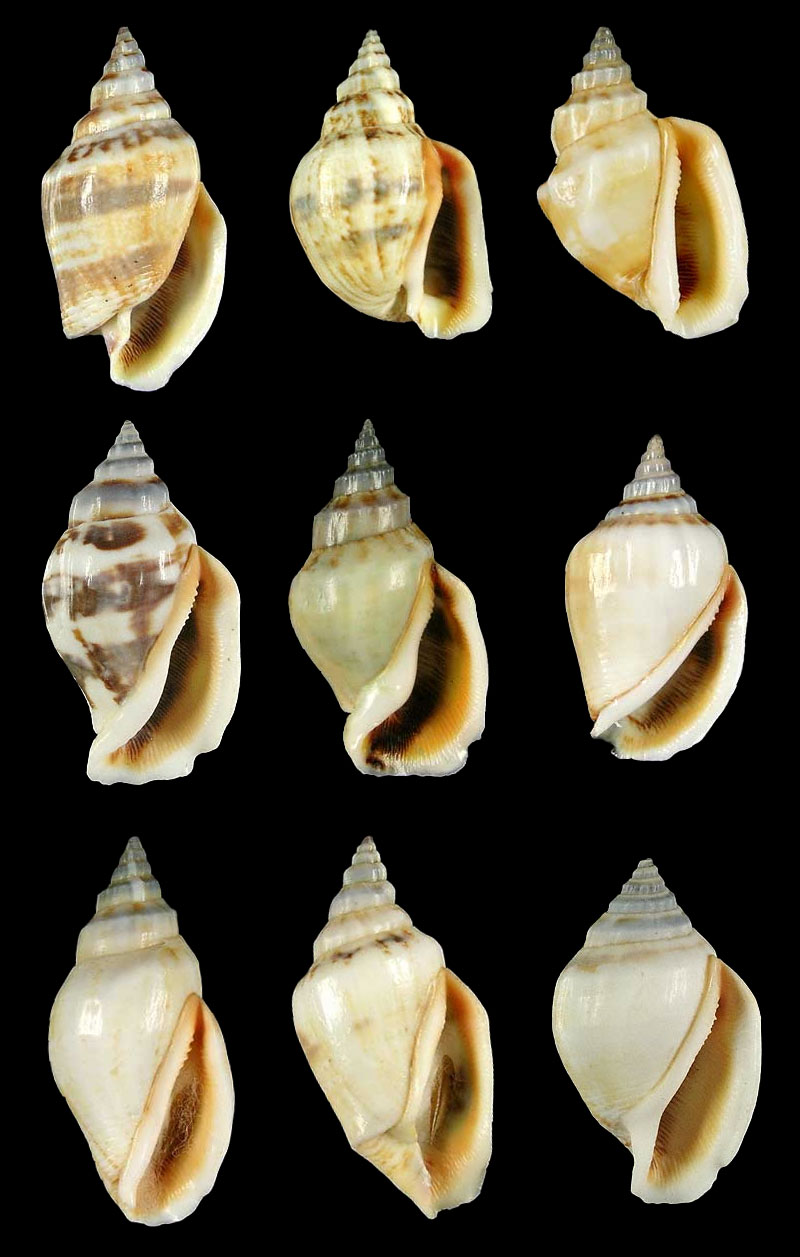 Canarium urceus (Linnaeus, 1758); freak forms; Philippines Islands; Coll. Guido & Philippe Poppe, Copyright Guido & Philippe Poppe
- tl: Masbate Island, Masbate Province, Bicol Region; collected from local fishermen. 2006; 46,9 mm; no. 320025
- tm: Olango Island, Cebu Province, Central Visayas Region; taken 10-25 m during nightdive; 2007; 39,8 mm; no. 404193
- tr: Olango Island, Cebu Province, Central Visayas Region; 10-25 m; collected by local fishermen; 2009; 33 mm; no. 545902
- ml: Olango Island, Cebu Province, Central Visayas Region; 25 m; 2003; 42,1 mm; no. 177240
- mm: Balabac Island, southern Palawan Province, Mimaropa Region; between 15-20 m; collected by fishernan; 2008; 40,5 mm; no. 479020
- mr: Cawoi Island, Olango Island Group, Cebu Province, Central Visayas Region; taken at 20-25 meters deep during nightdive; collected by local fishermen; 2007; 39,3 mm; no. 414425
- bl: Olango Island, Cebu Province, Central Visayas Region; from local fishermen; 2005; 42,1 mm; no. 274183
- bm: Olango Island, Cebu Province, Central Visayas Region; from local fishermen; 2005; 58,9 mm; no. 420388
- br: Olango Island, Cebu Province, Central Visayas Region; 25 m; 2003; 32,5 mm; no. 177345
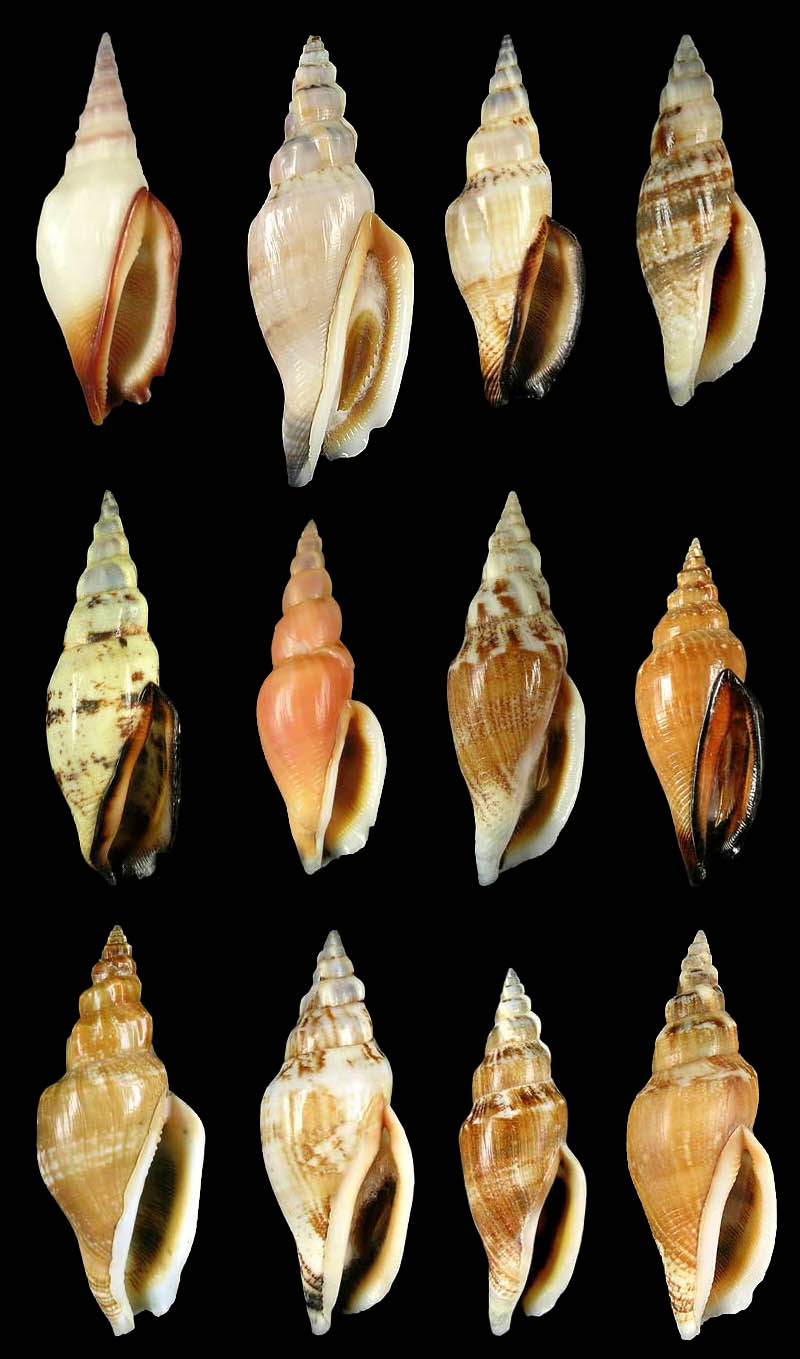 Canarium urceus (Linnaeus, 1758); freak forms; Philippines Islands; Coll. Guido & Philippe Poppe; Copyright Guido & Philippe Poppe
- t1 (l): Oslob, south of Cebu Island, Central Visayas Region; tangled nets at 50-150 m; collected by local fishermen; 2010; 34,3 mm. Tangled in deep water, this strange dead collected Strombus which may be a freak of C. urceus or another species ? Very high sharp spire; no. 573034
- t2: Olango Island, Cebu Province, Central Visayas Region; 10-25 m; 2010; 50,7 mm; no. 575695
- t3: Coron Island, Palawan Province, Mimaropa Region; Between 10-25 m; from local fisherman; 2006; 59,7 mm; no. 323976
- t4 (r): Bohol Island, Bohol Province, Central Visayas Region; taken at about 20 m; 2006; 39,8 mm; no. 363075
- m1: Coron Island, Palawan Province, Mimaropa Region; from fishermen; between 10-25 m; July 2005; 71,5 mm; no. 261600
- m2: Mactan Island. Punta Engaño; Lumun-lumun; 30-60 m; 2011; 53,2 mm; no. 664650
- m3: Panglao Island, Bohol Province, Central Visayas Region; collected from local fishermen; 2006; 71 mm; no. 316926
- m4: Palawan Island, Palawan Province, Mimaropa Region; collected by local fishermen; 2007; 64 mm; no. 370557
- b1: Balabac Island, southern Palawan Province, Mimaropa Region; found between 10-25 m; collected by local fishermen; 2006; 51,3 mm; no. 587672
- b2: Palawan Island, Palawan Province, Mimaropa Region; collected at 10-25 m. 2007; 71,9 mm; no. 417412
- b3: Zamboanga, Mindanao Island, Zamboanga Peninsula Region; 25-35 m; collected by local fishermern; 2009; 80,5 mm; no. 529886
- b4: Panglao Island, Bohol Province, Central Visayas Region; from local fisherman; 2004; 70,7 mm; no. 145751
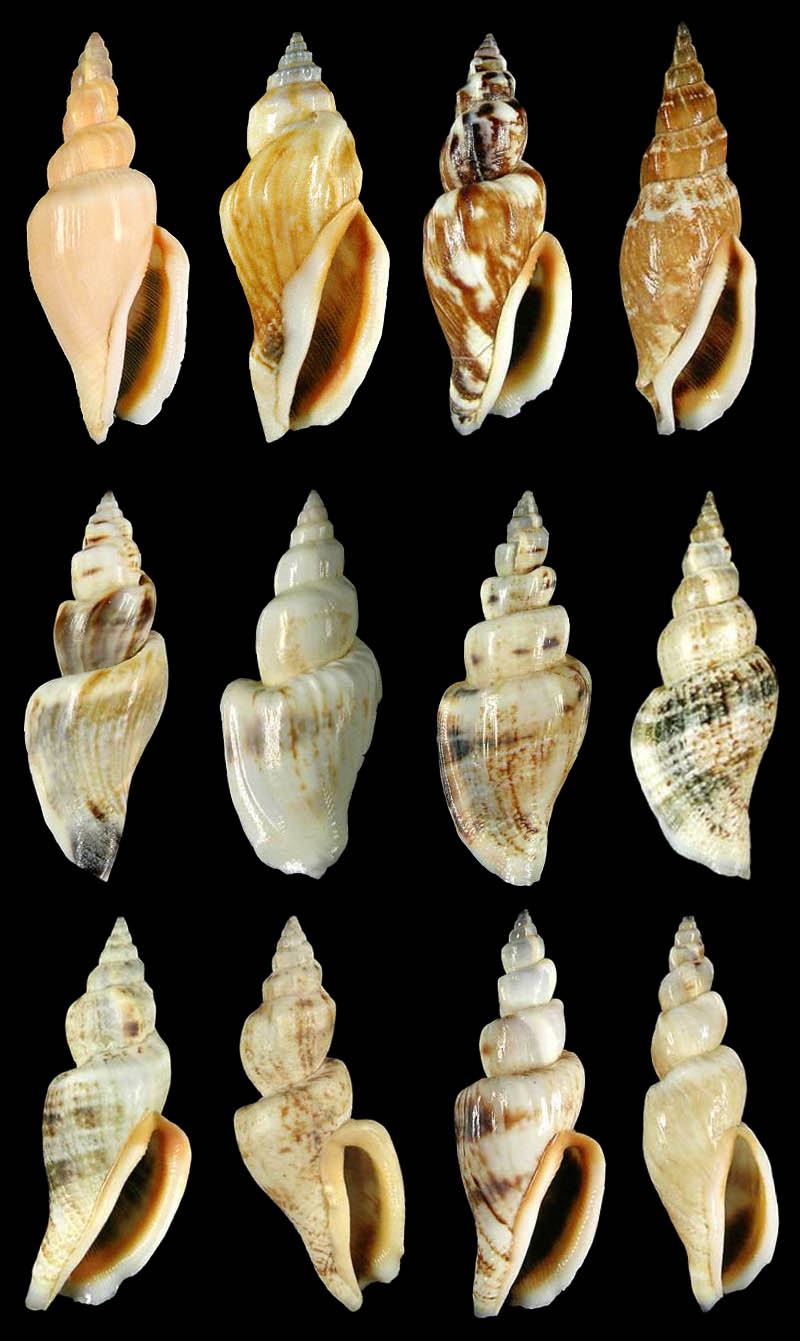 Canarium urceus (Linnaeus, 1758); freak forms; Coll. Guido & Philippe Poppe; Copyright Guido & Philippe Poppe
Canarium urceus (Linnaeus, 1758); freak forms; Coll. Guido & Philippe Poppe; Copyright Guido & Philippe Poppe
Canarium urceus (Linnaeus, 1758); freak forms; Coll. Guido & Philippe Poppe; Copyright Guido & Philippe Poppe
Canarium urceus (Linnaeus, 1758); Tuticorin, Tamil Nadu, South East India; shallow water in sandy mud with dead colrals, in sand; 5/2009; Coll. Ulrich Wieneke
Canarium urceus (Linnaeus, 1758); Semporna, Sabah, North Borneo; 36,0 mm; 7/2013; Coll. Ulrich Wieneke
Canarium urceus (Linnaeus, 1758); Tanapag Reef, Saipan Island, Marianas Archipelago, Northern Mariana Islands, Micronesia, USA; dead in rubble under loose coral, about 1 meter of water just inside the reef flat (intertidally); 47,5 mm; 2001-2002; collected by Doug Brennan; Dexter, Daryl & Donovan's shell collection
- Comment Doug Brennan: is the only one we logged into the collection. We do not normally collect them. Most of the ones we see have been washed up on the beach and are very worn.
- Comment Ulrich Wieneke: "This is a very unusual findspot. It might be a tourist shell or an Immigrant. Verification is needed."
Canarium urceus (Linnaeus, 1758); Mindelo, São Vicente Island, Republic of Cabo Verde, central Atlantic Ocean; 36,8 mm; dredging for construction of the port; Coll. Ramiro Fiadeiro
- Comment Ulrich Wieneke: "This is a very unusual findspot. It might be a tourist shell or an Immigrant. Verification is needed."
Canarium urceus (Linnaeus, 1758); 5 km south of Port Dickson, Malaysia; 49,5 mm; Coll. Ulrich Wieneke
Canarium urceus (Linnaeus, 1758); Pattaya, Chonburi Province, east coast of the Gulf of Thailand, Thailand; in sand trawled; 52,3 mm; 2003; Coll. Frank Nolf no. 03332b
Canarium urceus incisus (W. Wood, 1828); Marau Sound, Guadalcanal Island, Guadalcanal Province, Solomon Islands, south-western Pacific; by diver at 30 m at night; Coll. Gijs Kronenberg no. 653
Canarium urceus incisus (W. Wood, 1828); Malaita Island, Malaita Province, Solomon Islands, south-western Pacific; Coll. Frank Nolf no. 02434
Canarium urceus incisus (W. Wood, 1828); Mele beach, Efate Island, Vanuatu Archipelago (formerly New Hebrides), South Pacific Ocean; snorkeling at 3' to 5', dead; 8/1999; Coll. Gijs Kronenberg no. 598
Canarium urceus incisus (W. Wood, 1828); Langa Langa Lagoon, Malaita Island, Malaita Province, Solomon Islands, south-western Pacific; Coll. Gijs Kronenberg no. 515
Canarium urceus incisum (W. Wood, 1828); Yandina, Mbanika Island, Russell group, Solomon Islands, south-western Pacific; at night by Scuba diver, 30 ft;
1.r: 22 mm,
2.r: 23 mm; b: Munda, Roviana Lagoon, North Western Georgia, Solomon Islands, south-western Pacific; 19 mm; 1981; Coll. Christian Börnke
Canarium urceus incisus (W. Wood, 1828); Lissenung, Kavieng, New Ireland, Papua New Guinea; in shallow water; 22 mm; Collected by & coll. Christian Börnke
Canarium urceus incisus (W. Wood, 1828); Siquijor Island, Siquijor Province, Central Visayas Region, Philippines; Hookah divers, 40-70 m; 29,5 mm; 6/2012; Coll. Ulrich Wieneke
Canarium urceus incisus (W. Wood, 1828); Kermadec Islands, New Zealand; 27,9 mm; 2003; dived alive on sand grass by night at 20-25 m; Coll. Ulrich Wieneke
Canarium urceus incisus (W. Wood, 1828; Rabaul, Papua New Guinea; at low tide; Coll. Ulrich Wieneke
Canarium urceus incisus (W. Wood, 1828); Yanbaru, north of Okinawa Island, Okinawa Prefecture, Ryukyu Islands, Japan; 36 mm; fresh dead in sand; Coll. Ulrich Wieneke
Canarium urceus orrae (Abbott, 1960); Broome, Kimberley Region, Western Australia State, Australia; collected at low tide; 1.r: 40 mm, 2.r: 40 mm, 3.r: 38 mm, 4.r: 37 mm, 5.r: 36 m; 1985; Coll. Christian Börnke
Strombus urceus orrae (Abbott, 1960); Broome, Kimberley Region, Western Australia State, Australia; Coll. Gijs Kronenberg no. 5676
Strombus urceus orrae (Abbott, 1960); Drimmie Head, Northern Territory, Australia; at low tide on sand flats; Coll. Gijs Kronenberg no. 5924
Canarium urceus orrae (Abbott, 1960); Monte Belo Islands, Western Australia State, Australia; 1982; Coll. Gijs Kronenberg no. 538
Canarium urceus orrae (Abbott, 1960); Western Australia State, Australia; t: 41 mm, b: 48 mm; Coll. Paul Merril
Specimens from institutional collections
Canarium (Canarium) plicatus var. ustulatus; Pleisto-Pliocene; Nias Island, North Sumatra Province, Indonesia; Coll. Naturalis Leiden
Canarium (Canarium) plicatus var. ustulatus; Pleisto-Pliocene; Nias Island, North Sumatra Province, Indonesia; Coll. Naturalis Leiden
- Comment Ulrich Wieneke: "This is the similar form as that Abbott, 1960, p. 64 referred to as "Geelvink" form."
Strombus plicatus; Oi Kloi(?), West Timor, Indonesia; Coll. Naturalis Leiden
- Comment Ulrich Wieneke: "This is the same form as that Abbott, 1960, p. 64 referred to as "Geelvink" form."
Photos of Living Specimens
Canarium urceus (Linnaeus, 1758); Singapore; Photo & Copyright James Koh
References
- Abbott, 1960
- Sylvanus Hanley, 1855. Ipsa Linnaei Conchylia. The Shells of Linnaeus, detemined from his manuscripts and collection. Williams and Norgate, London. pp. 1-556, pl. I-V.
- Link, H. F. 1807. Beschreibung der Naturalien-Sammlung der Universität zu Rostock. Abtheilung 3. - pp. 101-165. Rostock. (Adler). (Fulltext)
- Liverani V. (2014) The superfamily Stromboidea. Addenda and corrigenda. In: G.T. Poppe, K. Groh & C. Renker (eds), A conchological iconography. pp. 1-54, pls 131-164. Harxheim: Conchbooks.
- Man in't Veld, L., 1988. Strombus urceus incisus, a misunderstood species; La Conchiglia 228/229: 6-9.
- Schumacher, C. F. 1817. Essai d'un nouveau système des habitations des vers testacés. Avec XXII planches. - pp. [1-3], 1-287, Pl. I-XXII [= 1-22]. Copenhague. (Schultz). (Fulltext)
- Watson, R.B. (1885). Report on the Scaphopoda and Gastropoda collected by "H.M.S. Challenger" during the years 1873-76. Report on the Scientific Results of the Voyage of "H.M.S. Challenger" during the years 1873-76. Zoology. Vol. XV(II). pp. i-v, 1-756, 50 pls.
- Barry Wilson, 2013. The Biogeography of the Australian North West Shelf: Environmental Change and Life's Response; Newnes, pp. 640.
|


